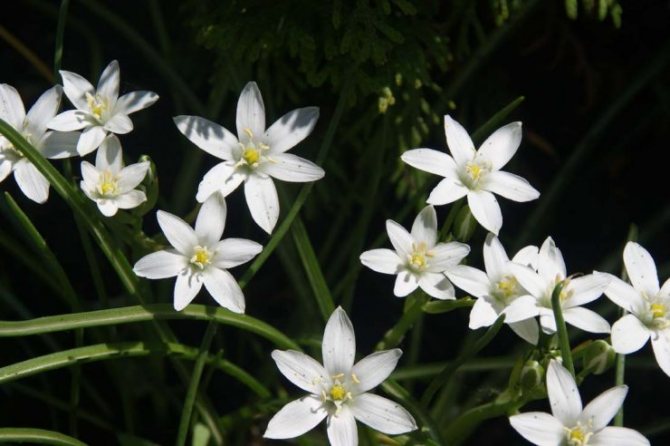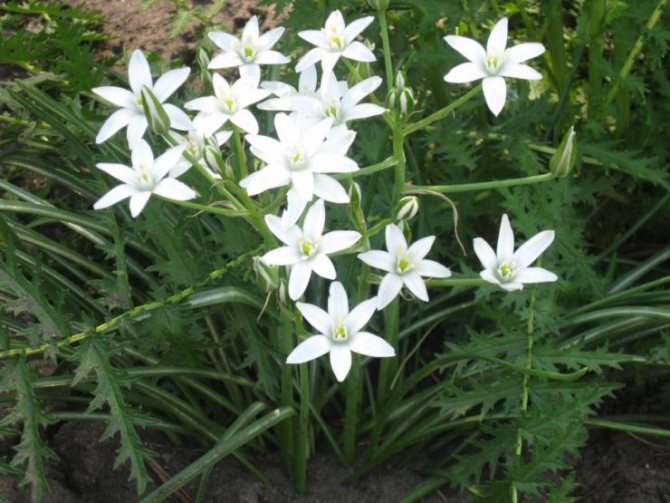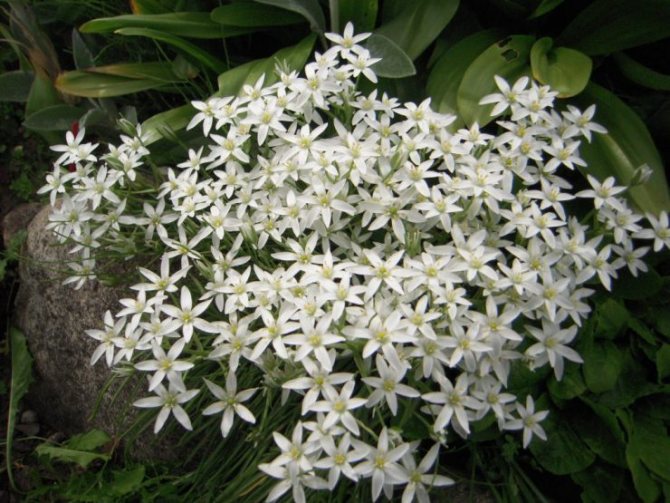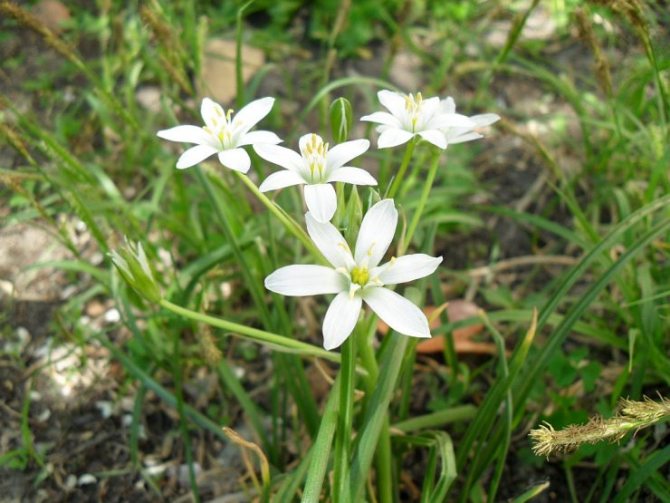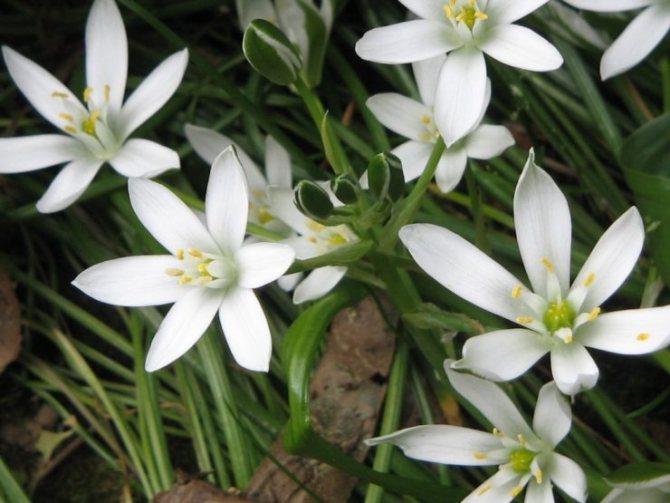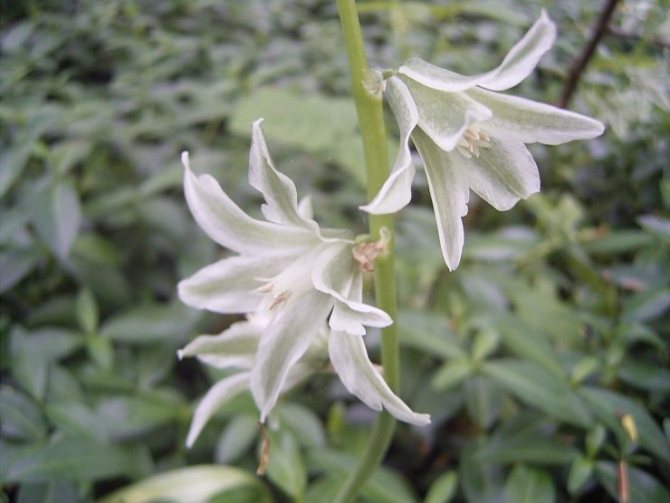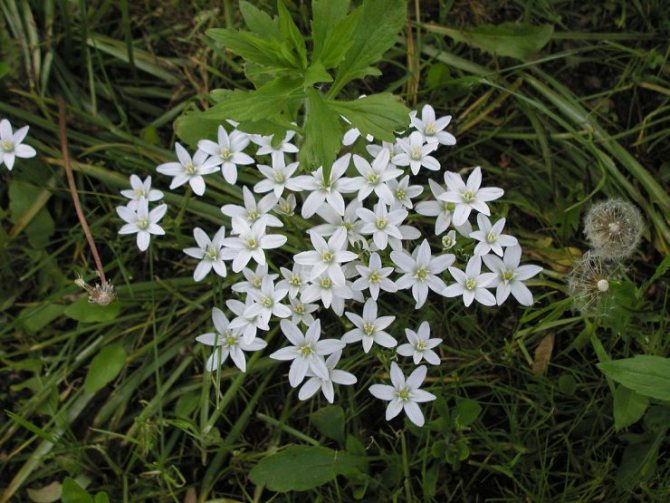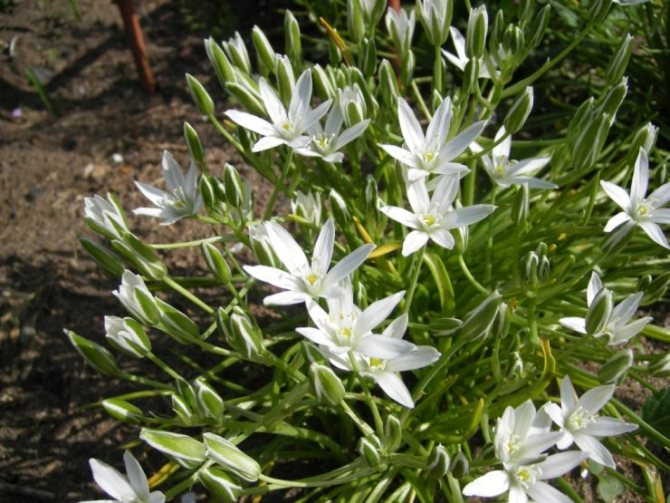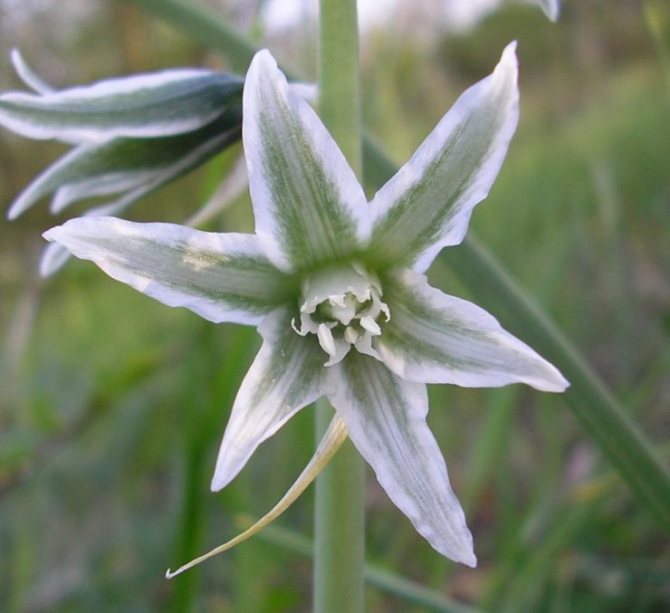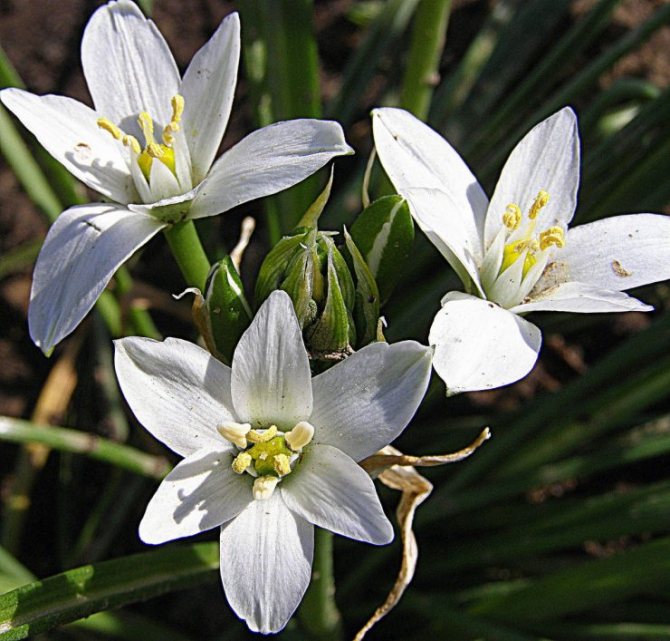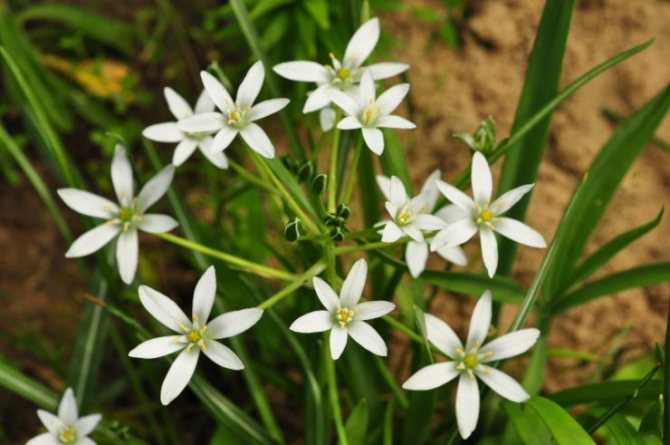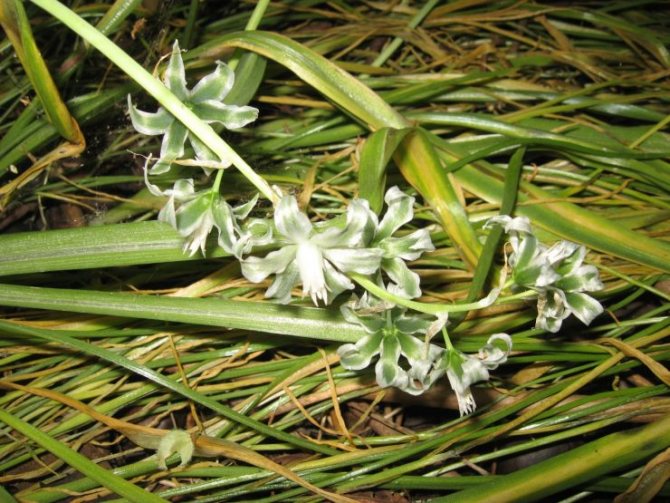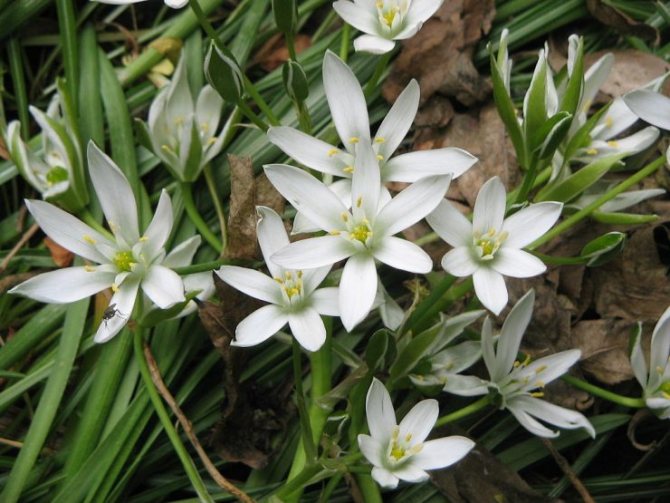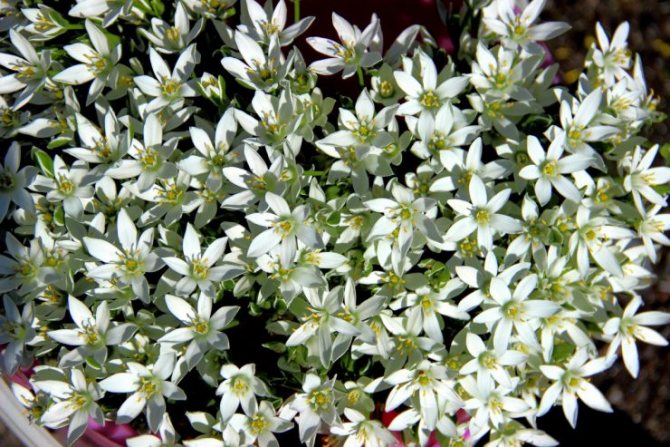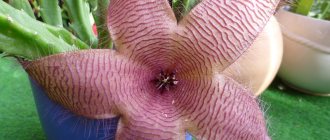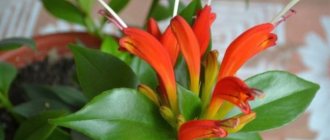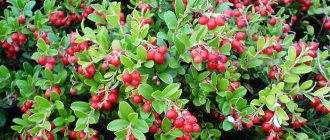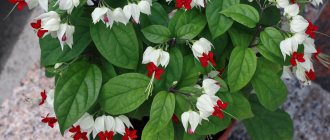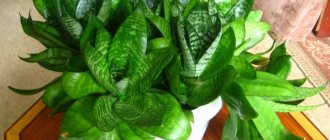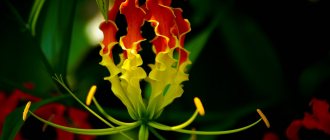Bulbous herbaceous perennial plant of the poultry plant (Ornithogalum), or ornithogalum, is a member of the hyacinth subfamily of the asparagus family. Under natural conditions, it can be found in the subtropical and temperate regions of South Africa, the Mediterranean and Western Asia. 1 species of ornithogalum grows in South America, several in Eurasia and 4 in North America. In total, there are about 150 species of poultry farms. The Latin name of the plant consists of two words: "ornis", which translates as "bird" and "gala" - meaning "milk", as a result, "bird's milk" is obtained. This plant has flowers of a very unusual star-shaped form, due to which it is called the "star of Bethlehem" in England and the "milk star" in Germany.
Ornithogalum (poultry farm): care and cultivation
The flower acquired its beautiful and unusual name from a combination of two Greek words - "ornito" and "gala", which translates as "bird's milk". Previously, he belonged to the Liliaceae family, but today he is ranked among the Asparagus. Ornithogalum is found in the Mediterranean, Western Asia, South Africa, America and Eurasia. People have known the poultry farm since the 16th century; it was used for food and even for medicinal purposes.

Poultry Farm Photos
Poultry varieties
Below are the most popular and common types.
| View | Description |
| Arab | It grows to a length of about 0.85 m, small white flowers 5 cm in diameter. |
| Boucher | Height about 0.5 m, inflorescences are racemose and up to 50 flowers of green color. |
| Doubtful | It has an orange, yellow, red or white color, a racemose inflorescence. Due to its ability not to fade for a long time, this flower is often used by florists when drawing up bouquets. |
| Fisher | Height up to 0.6 m, racemose inflorescences, about 0.25 m long with many (up to 20) small white flowers. |
| Drooping | It reaches a height of 0.5 m. It got its name due to the drooping type of inflorescences with up to 12 flowers. |
| Balances (Schmalhausen) | The height of the bush is small, only 0.1 m. On the peduncle there are 3 white flowers with thin stripes of green in the center of each petal. The diameter of each flower is 3 cm. |
| Narbonne | In height, the bush can reach up to 0.8 m, the color of the flowers is greenish. |
| Tailed (or Indian bow) | Despite the fact that the plant is poisonous, it has medicinal properties. The bush consists of several hanging flat leaves, wide at the base and pointed at the ends, their length can reach 0.8 m. White flowers are white with a greenish core. |
| Umbrella | This type is considered the most popular among gardeners. The plant can grow up to 0.25 m in height. It got its name due to the similarity of a white flower with an open umbrella. |
| Pyramidal | It reaches a height of 1 m. The color of the flowers is white with a greenish tint. |
Features of the poultry farm
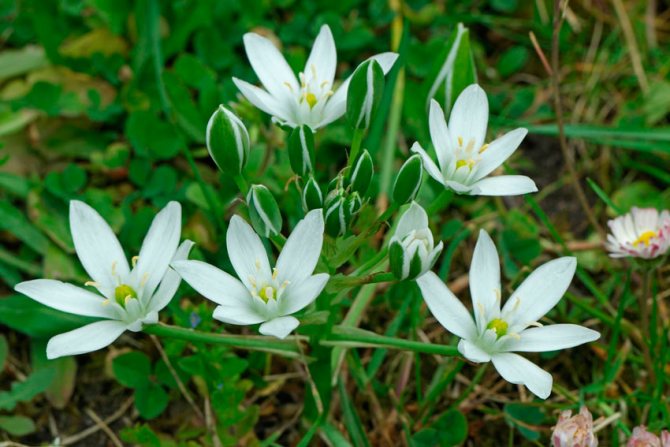

The height of the ornithogalum bush can vary from 0.3 to 0.85 m. The diameter of the bulbs is 2–5 centimeters, and their shape can be ovoid, round or oblong. On their surface there are dense covering scales.Basal leaf plates of a belt-like or linear shape with a whitish central vein grow somewhat earlier than flower arrows. There are species in which foliage grows in the autumn, and it remains on the bush in the winter, and dries up in the summer. Inflorescences of racemose or corymbose form consist of light yellow or white flowers, they have no aroma, but on the front surface of the tepals there is a strip of green color. The fruit is a box, inside of which there are flat, rounded black seeds.
If you are going to grow this plant, then do not forget that there are poisonous species, they have cardiac glycosides, and unidentified alkaloids may also be present. Other types of sprouts and bulbs are edible and eaten like asparagus. About 10 species of ornithogalum are cultivated.
Below it will be described in detail how to plant, grow and propagate this flower, and also talk about its medicinal properties.
Planting a poultry farm in open ground and care
Three types of poultry farms are most suitable for growing in garden plots: Balance, umbrella and drooping. These varieties take root well and can even withstand severe winter chills; they do not even require a special greenhouse or any kind of shelter.
Ornithogalum likes daylight, but it also feels comfortable in the shade. This plant does not even take root on fertile and loamy soil. The main condition that must be observed when planting is the absence of stagnant water, otherwise the bulbs can rot. To avoid this, it is enough to put rubble or broken brick on the bottom of the planting holes to protect the bulbs from moisture.
He does not need special feeding, he receives all the necessary useful elements on his own. But it requires regular, but rather moderate watering. may die from waterlogging. During flowering, it must be cut back.
Ornithogalum planting dates
Ornithogalum is usually planted at the end of the summer season (last days of August - early September) in loose soil. There should not be a distance of less than 15 cm between the planted bulbs so that the bushes do not interfere with each other during germination. Poultry farms planted in summer take root in the soil in winter, and in spring they begin to germinate and bloom.
Landing
For ornithogalum, the soil composition does not play an important role. However, in a fertile substrate, it will develop more intensively. The soil should be light and water permeable. To avoid stagnation of moisture that is harmful to the flower, a drainage layer is placed on the bottom of the pot. The latter can be made from fine gravel, brick chips. Planting depth is twice the height of the bulb.
Planting in open ground is also possible, caring for the flower in the future will not be difficult. If the gardener decides to decorate the site with an unusual flower, the timing should be determined. In most areas, they occur in the spring, when the soil warms up to 8-10 ° C, and a stable heat is established. In the southern regions, the bulbs are planted in open ground in late August or early September.
Transfer
During the cultivation of the poultry farm, the main condition is timely transplantation. When the bulb is in the soil for a long time, it begins to grow abundantly with children, and this does not have the best effect on the general appearance and condition of the plant.
In one place, the bush can be no more than 5-6 years. But for better health, ornithogalum is best transplanted every 4 years.
The origin of the name of the tailed bird
The tailed bird poultry is a perennial plant, belongs to the lily family (Liliaceae) and the poultry poultry genus.
The botanical name of the plant is of Greek origin. So, in Greek, the tailed birdhouse is called Ornithogalum caudatum: "ornis" is translated as "bird", and "gala" means "milk". The literal interpretation sounds like "bird's milk".
Most likely, this plant was named for its graceful white flowers. But some sources also mention that its flowers have a subtle vanilla smell and smell exactly the same as the candies of the same name.
Apparently, this played a role in the selection of the name for the flower. The word "tailed" was subsequently attached to the name of the poultry farm, most likely due to the fact that the long leaves of the plant, growing not straight up, but slightly hanging down, resemble the shape of the tail feathers of a rooster.
Ornithogalum is popularly called the Indian onion for its resemblance to the onion.
Reproduction
The poultry poultry reproduces in two ways:
- children;
- seeds.
Children separated from the bulb are planted separately in sunny places or near trees in late summer (last days of August - early September) or in spring.
Reproduction by seeds occurs as follows: the seed is planted in the ground in a shallow hole before the onset of winter, and shoots are awaited in the spring.
But it should be borne in mind that planting in both ways is a long process. It will take about 3-4 years for the bush to bloom.
Features of the poultry plant or ornithogalum
The birdhouse or ornithogalum has its own external characteristic features that distinguish it from other cultures.
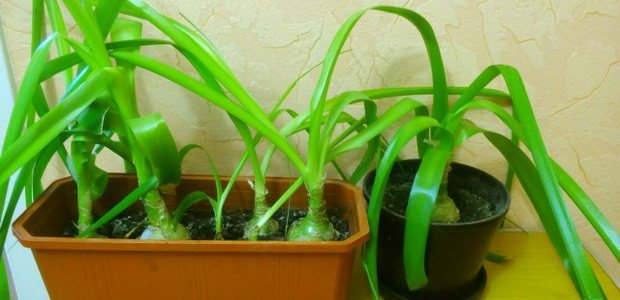

This is a perennial bulbous plant, the height of which varies from 30 to 85 cm. In flower beds, this culture most often reaches 60 cm. The bulb is round or ovoid, with a diameter of 2 to 5 cm. The surface of the bulb is covered with dense transparent scales.
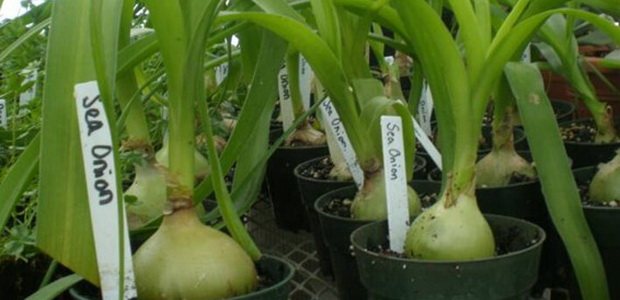

The bulbs themselves are not edible, but are used in the preparation of infusions, steams and juice. The content of the poison in them is much higher than in the leaves.


Its leaves are narrow and lanceolate-belt-shaped. The width can be from 2.5 to 3 centimeters. In length they reach 60 centimeters. By their structure, the leaves are delicate, on the cut they emit a jelly-like juice. The leaves never stand straight, but wriggle slightly, and therefore in some cases (when you want to give the plant a decorative look), they require props, and not one, but several at once.
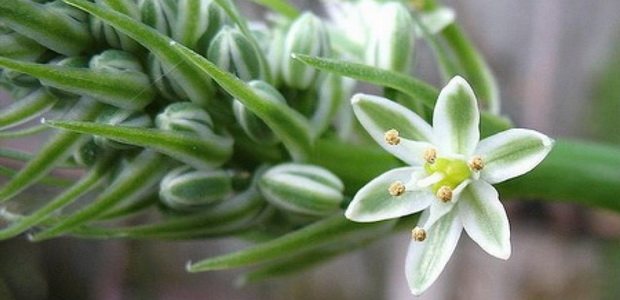

Looking at the plant, you will notice that the tips of its leaves are often slightly curled up into a tube. Moreover, at the very edge, the tip usually also dries up, but the base continues to grow, and this is quite normal. No need to panic and start thinking that the tailed poultry farm needs more watering. Nothing of the kind - he feels great.
If you separate the leaf of the plant from the bulb, you can see how quickly the milky juice begins to stand out from it. This juice, in contact with the skin, can cause severe burning and itching for 10-15 minutes.
The foliage of most types of poultry farms is formed somewhat earlier than the peduncles. In some species, leaves appear in the fall, persist throughout the winter, and die off in the summer.
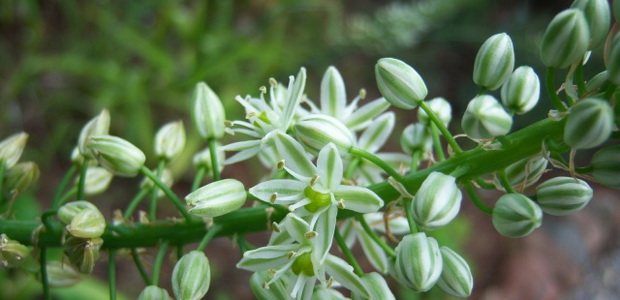

The peduncle is dense, up to 90 cm high. The inflorescence is multi-flowered, racemose or corymbose. Flowers 1 - 3 cm in diameter, wide open, almost stellate, white or yellowish with a green back; there are yellow, yellow-brown and even red lead.
The flowering time of this plant falls in mid-October and the first half of November. Sometimes deviations from this schedule are possible. Most often they are associated with climate change, with its sharp warming, especially in the winter season.
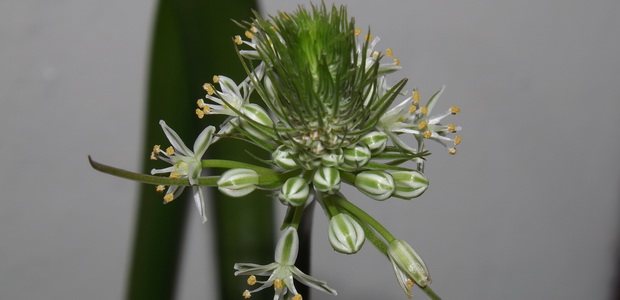

Indian onions give an arrow only in the third year after planting, so you should not expect flowering in the first years after transplanting the bulbs into separate pots. The length of the arrow itself can be up to 1 meter.
The discarded arrow is sinuous, rather dense, without a void inside. The number of flowers on one arrow can be hundreds.
The flowering of the plant itself lasts a long time, because the greenish flowers do not bloom simultaneously, but sequentially one after another, from the base of the inflorescence to its top.
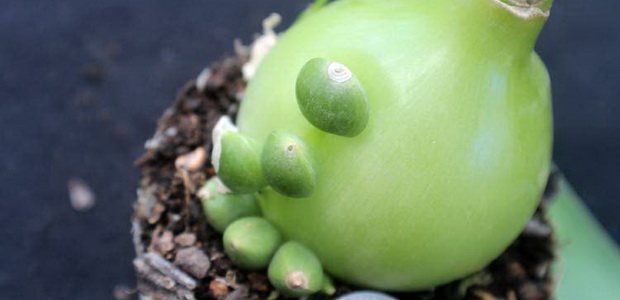

The seeds of Indian onions are formed only after pollination of the flowers, therefore, at home, the poultry farm must be artificially pollinated, otherwise fruiting will not occur.
It happens that the last flower appears simultaneously with the ripening of the seeds at the base.
After the flower arrows reach a height of 20 centimeters, they should be broken so that the plant does not waste energy on unnecessary bends and grows better.
As for the fruits, in the poultry farm they are a black box with small black seeds inside.
The botanical description of the bird plant (ornithogalum) flower is supplemented by the photo below, in which you can consider all its characteristic features:
Application in landscape design
The poultry garden is an undemanding plant, but very beautiful. A scattering of white stars will be an excellent decoration for any area.


The bushes are usually planted by those gardeners who need to achieve continuous flowering in their garden. The poultry garden blooms when other plants, as a rule, go into hibernation or gain strength for flowering.
Also, this plant fell in love with gardeners due to its unpretentiousness and ability to get along on any, even on infertile soil, which cannot be said about many other flowers.
Another plus is that it is in perfect harmony with any other flower, creating an attractive overall garden composition.
Application
Since there may be an individual intolerance or an allergic reaction to Poultry Farm, in order to prevent such manifestations, you need to apply a little of the drug to the skin to see the reaction.
In official medicine, the poultry plant is not widely used, but it is actively used in folk recipes.
Anti-inflammatory, wound healing and antimicrobial properties allow the plant to be used in the treatment of migraines, severe headaches, joint diseases, pathologies of the vascular and respiratory systems.
ethnoscience
The plant is used in the preparation of aqueous and alcoholic infusions, decoctions, compresses, gruels.
Recipes:
Headache and migraine
Rub a few drops of juice into temples, back of head and shoulders.
Runny nose
Rub a small amount of freshly squeezed juice into the bridge of the nose and the wings of the nose. Rub in up to 3 times a day in the initial stages of the disease.


The poultry house helps to cope with the common cold
Sore throat
It is better not to do the broth, as the product can get inside. Therefore, a compress is being prepared. It is necessary to cut the leaves of the flower and fill them with warm boiled water in a ratio of 1:10.
Keep for 10-15 minutes in a water bath.
After preparing the infusion, soak a bandage in it, wrap it around the throat and leave for 3 minutes.
Joint pathologies
For treatment, you will need to prepare an ointment for external use based on fat, petroleum jelly or oil.
It is necessary to prepare the ointment for one application, since it cannot be stored for a long time.
You need to take 1 part of olive oil and Vishnevsky ointment and 0.5 part of fir oil and freshly squeezed juice of Poultry. Combine ingredients and rub into sore joints.
Radiculitis
To relieve sciatica, an alcoholic tincture is prepared. You need to take one adult Birdhouse and grind all its parts (onion, leaves, stem) in a meat grinder. Pour the resulting gruel with 200 ml of vodka and leave for a week. Then strain the resulting mixture and rub into the back.


With radiculitis, the birdhouse is an excellent helper
Cosmetology
In cosmetology, the poultry plant is used to remove hardened skin and increase the speed of metabolic processes.
In the role of masks and tonics for the face, Poultry Manor relieves inflammation well and dries problem skin.
Recipes:
Balm for face and neck
You need to take the flowers and leaves of the plant and mix them with vodka in a ratio of 1:20.
Determine the product in the refrigerator in a dark container for 50 days, then strain.
Then apply in the form:
- Compress - put napkins soaked in the product on the face and neck, wrap it with a scarf on top. After 20 minutes, remove and wash off the remnants of the product from the face.
- Masks - mix the infusion, white clay and water until a mushy consistency is obtained. Apply to face, wait 15 minutes, then rinse thoroughly.
- Toner - for rubbing the face with cotton wool.


Poultry face mask - the key to beautiful and healthy skin
Growing ornithogalum indoors
Ornithogalum is so easy to plant and care for that it can be grown without any problems even on a windowsill. For home breeding, bulbs are used (for example, ornithogalum Arabian and tailed), a volumetric pot and fertile soil.
The growing container should not be too large and deep, as the bulb forms many children and the poultry farm will not bloom.
It is important to observe the temperature regime (+ 17 ... + 25 ˚С), the absence of drafts, especially in winter. Also, you cannot place a container with a plant near a heat source (batteries, heaters, fireplaces, etc.), because from dry air, ornithogalum can dry out and get sick.
It is categorically impossible to fill the plant with water, this can cause rotting and subsequent death. Water should be well absorbed into the ground, and the next watering is done when the top layer of the earth is dry.
Short daylight hours can adversely affect the poultry farm, therefore, during flowering, it is better to illuminate it with special phytolamps. When choosing a place, you need to focus on the east or south side of the house, there the ornithogalum will receive enough light.
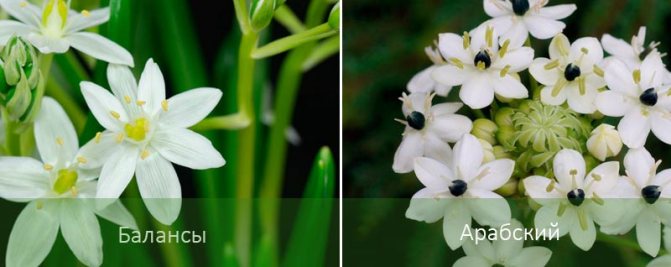

When growing in a house, the poultry farm needs fertilizing with mineral and organic fertilizers, which can be alternated. It is necessary to feed no more than 1 time per month.
Reproduction methods
Ornithogalum can be propagated in different ways.
Cuttings
Rhododendron: planting and care in the open field
Poultry cuttings allow growing young and strong plants in a relatively short time. To obtain cuttings, a five to seven-year-old plant is dug up, cleaned of soil and dried in the sun. Then, daughter bulbs with already formed roots are separated from the large onion. Further, they will only have to be planted in a sunny or semi-shaded area.
From seed
Reproduction of a poultry farm from seeds is a very laborious and troublesome process. Nevertheless, some growers resort to it. Seeds before sowing (about three months) are placed in a refrigerator to stratify them. Sowing is carried out in a mixture of sand and peat and covered with a film, periodically ventilated. The soil is moistened from time to time with a spray bottle.
Seedlings appear with the onset of spring. After that, they remove the film and wait for the young growth to get stronger a little. Then it is transplanted into separate pots and grown until next spring.
Additional Information! The poultry yard is not propagated by dividing the bush and layering.
Mr. Dachnik advises: the medicinal properties of ornithogalum
In folk medicine, this plant occupies one of the leading places in terms of its beneficial properties. In the treatment of various diseases and ailments, bulbs, flowers, leaves and even poultry juice are used. It kills germs and viruses, has a healing effect (it pulls together small cuts and abrasions well), relieves swelling, relieves pain, and also disinfects the air in the room in which it grows.
Therefore, ornithogalum (birdhouse) is not only a beautiful and graceful plant that can decorate any garden, but also a real natural doctor.
The benefits of the poultry farm
The birdhouse flower has antiseptic and wound healing properties.It helps to quickly heal bruises, cuts, relieves swelling and inflammation, and has an analgesic effect.


Indoors, it is used to clean the air from microbes, due to the content of phytoncides.
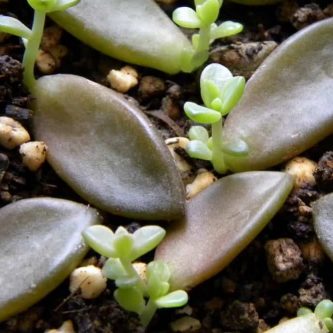

How to properly care for a money tree: transplantation, reproduction, circumcision, disease. 30+ photos, signs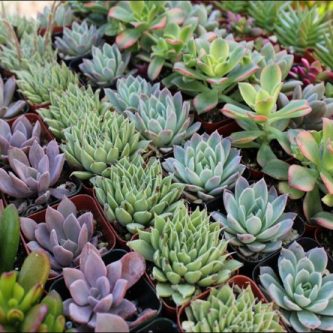

Echeveria - how to care for indoor succulent plants? Watering and soil selection features (55 photos + video)
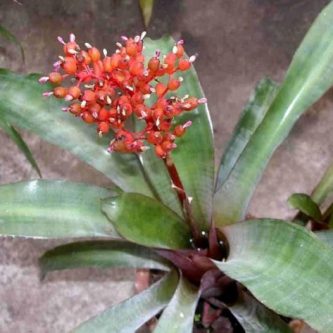

Ehmeya: indoor ornamental flowering plant. Nursing feeding and reproduction (54 photos)
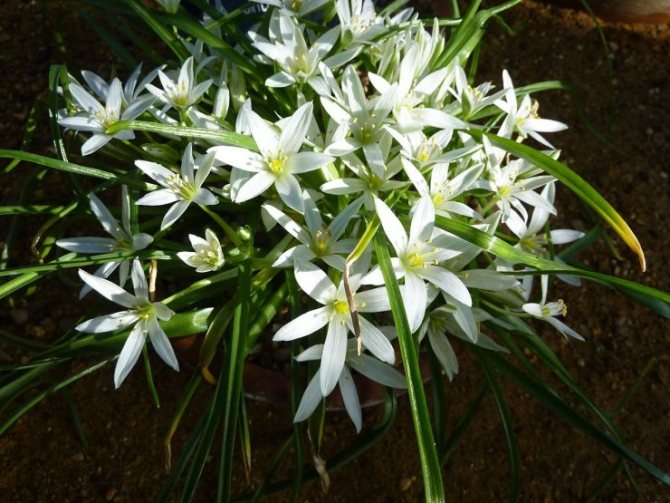

Poultry
Botanical name: Ornithogalum.
Birdhouse flower - family ... Hyacinth.
Origin ... South Africa, Europe.
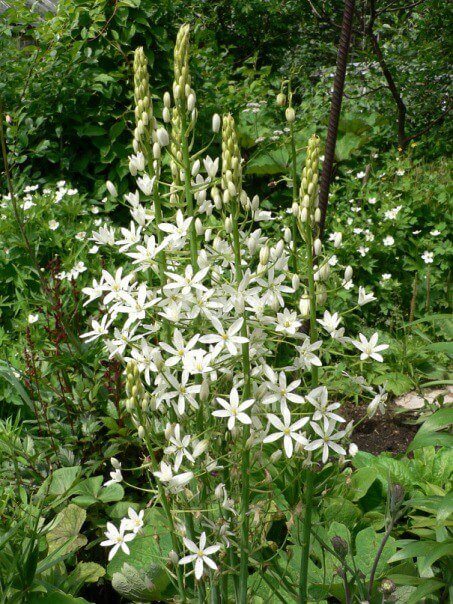

Description ... The poultry plant, Indian onion or ornithogalum is a perennial, often small bulbous plant. Bulbs are ovate, up to 10 cm in diameter. The leaves are narrow, belt-like, thin, 30 - 80 cm long, dark green in color, with longitudinal veins, form a basal rosette. Peduncles are tall - from 30 to 80 cm, leafless, bear at the top from 20 to 100 stellate white or greenish flowers. Each flower is about 2.5 cm in diameter and has 6 pointed petals. Flowers open only in good weather - in cloudy weather they remain half-closed.
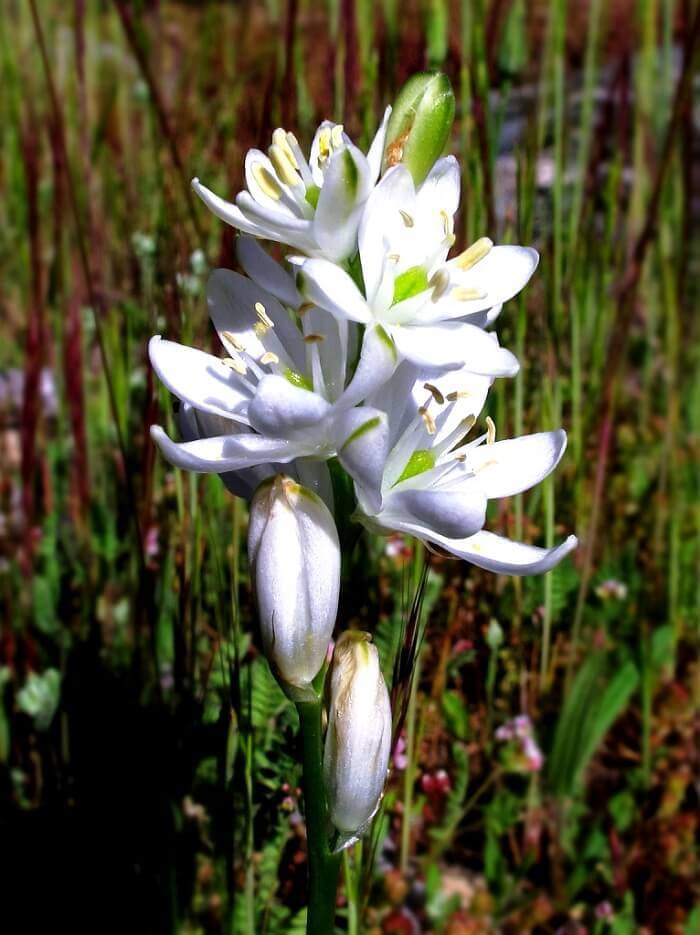

Height ... 30 - 100 cm, depending on the species.
Poultry arabic
The homeland of this thermophilic variety is the Mediterranean. Its peduncle grows up to 85 cm in height.


The inflorescence consists of several groups of flowers on long stalks. The leaves of the Arabian poultry farm are light green in color.


1.Planting and caring for the poultry farm
1.1 Growing at home
The poultry farm does not have a pronounced dormant period and grows throughout the year. Move the plant to fresh air during the warmer months.
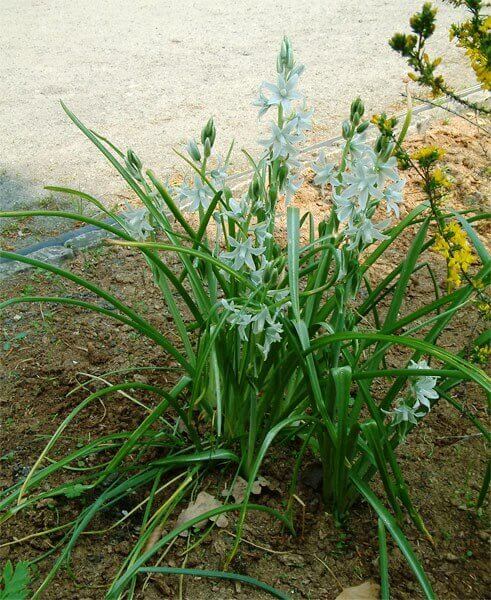

1.2 When the birdhouse blooms
1.3. Reproduction, poultry farm from seeds
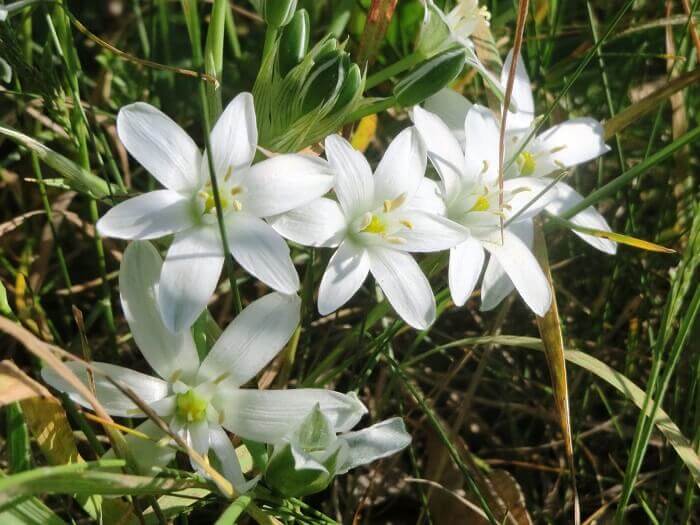

1.4 Soil
Use nutrient-rich and well-drained soil. A mixture of equal parts perlite and peat, sand.
1.5 Transplanting a poultry house
Bulbs can be planted at any time of the year when they get too crowded in the pot.
1.6 Top dressing
The poultry house can be fed monthly in spring and summer. In the fall, feeding is stopped and resumed with the beginning of new growth in the spring.
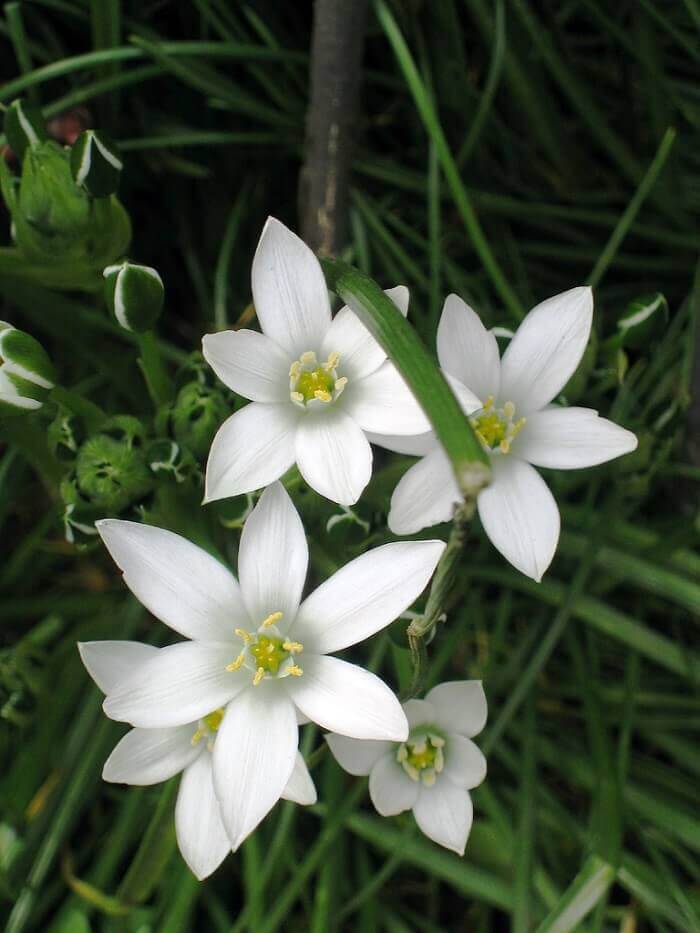

1.7 Diseases and pests
The plant rots when over-watered, especially during autumn and winter. Prolonged exposure to direct sun can cause burns. Leaves dry with prolonged drought.
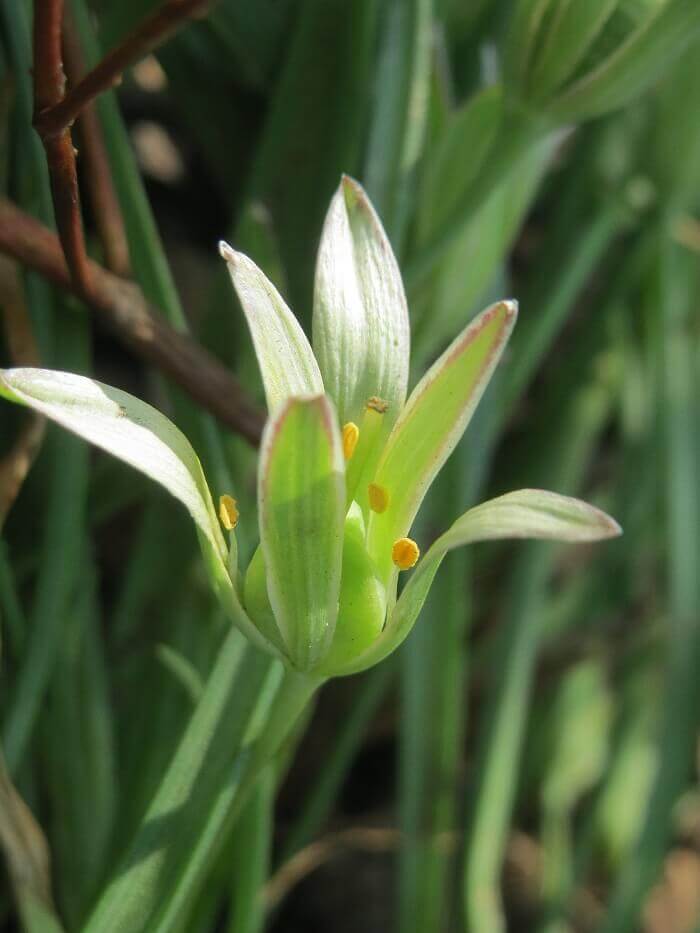

1.8 Temperature
The poultry house can be kept at normal room temperature throughout the year.
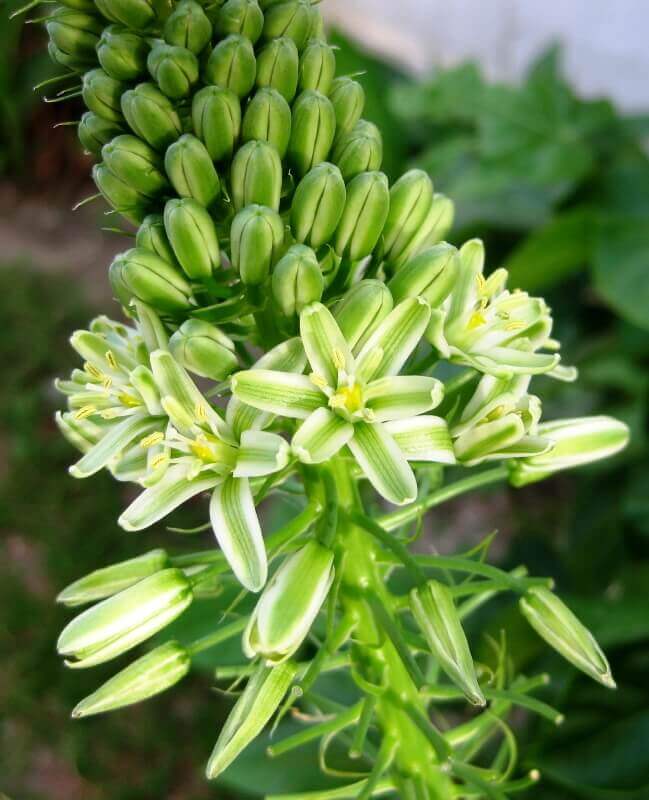

1.9 Lighting
Plants should receive direct sunlight for 3 to 4 hours daily. In the daytime, organize shading from the scorching rays.
1.10 Watering the poultry farm
Water sparingly but regularly during the summer months. The topsoil should dry out between waterings. Reduce the frequency of watering in the fall and keep the soil barely damp until spring.
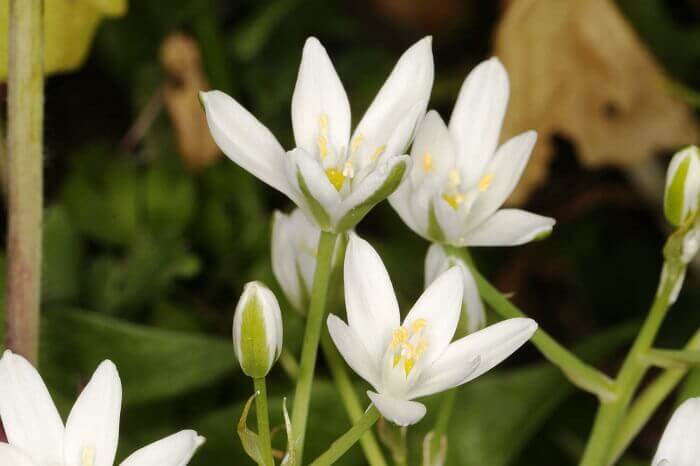

1.11 Spraying
Spray if the indoor air gets too dry.


1.12 Purpose
Looks great in balconies and terraces landscaping. These delicate perennials also look good when grown in hanging baskets.
1.13 Note
All parts of the plant are poisonous - keep it away from children and pets.
Hydroponics .
Poultry farm properties
Ornithogalum has a wound healing, analgesic and antimicrobial effect. With the help of this plant, they treat bruises and wounds, eliminate inflammation and painful sensations in the joints, cleanse the body of salt, treat pain in the head, and also use it for edema. If such a flower is grown at home, then it will purify the air in the apartment, since it contains a large amount of phytoncides.
It should be borne in mind that only the crested poultry farm, also called the Indian onion, has healing properties. Absolutely all parts of this plant, including flowers and bulbs, are medicinal.Moreover, such properties do not appear immediately, but only in the second year of life.
Varieties:
2.1. Poultry tailed poultry - Ornithogalum caudatum
Relatively large bulbous herb. It has a round, flaky light green bulb with a diameter of up to 10 cm. Leaves are green, linear, up to 90 cm long, curved along the central vein. During the flowering period, the plant throws out a tall leafless peduncle reaching 90 - 150 cm. At the top of the peduncle there is an inflorescence - an ear with greenish or white, fragrant flowers. Each peduncle is capable of bearing from 50 to 300 flowers.


2.2. Umbrella poultry - Ornithogalum Umbellatum
Bulbous perennial with compact size - often does not exceed a height of 30 cm.The leaves are dark green, linear, glossy, up to 30 cm long. Peduncles are leafless, 15-20 cm high, appear when the leaves begin to die off - in late spring or early summer. Each peduncle bears 15 - 20 flowers. The flowers are white, delicate, star-shaped - with 6 oblong petals, about 2 cm in diameter. On the outside, the petals have a wide green longitudinal stripe in the center.


2.3. Poultry Boucher - Ornithogalum boucheanum
Perennial herb with a bulb about 3-4 cm in diameter. The leaves are narrow, linear, green, 20 to 50 cm long, bent longitudinally along the central vein and often gracefully arched. Peduncles are strong, thick, erect, leafless, bearing 15 - 20 attractive light green flowers at the top. The flowers open sequentially - from bottom to top, which prolongs the flowering time.
2.4. Poultry nutans or wilted - Ornithogalum nutans
A perennial herb with a bulb up to 6 cm in diameter. The leaves are narrow, linear, dark green, 30 - 40 cm long. Strong erect peduncles reach a height of 50 - 60 cm, appear in spring. Each peduncle bears at the top up to 15 - 20 silvery - green star-shaped flowers with a very pleasant sweetish aroma. Flowers open sequentially - from bottom to top.


2.5. Doubtful birdhouse - Ornithogalum dubium
Perhaps the brightest representative of poultry farms is a compact herbaceous plant up to 30 cm high. The leaves are dark green, thick, fleshy, oblong-triangular, covered with a bluish waxy bloom, reminiscent of tulip foliage. Peduncles are erect, 30 - 40 cm high. Each peduncle bears at the top up to 15 - 20 brightly colored orange flowers with 6 wide petals. The center of the flowers is often colored dark brown, the buds open sequentially - from bottom to top. Flowering occurs in spring.


2.6. Birdhouse arabic - Ornithogalum arabicum
Leaves are green, oblong-triangular, basal. Leafless peduncles, up to 45 - 60 cm high, bear inflorescences on the tops with many delicate white or cream, fragrant flowers. Flowering occurs in the first half of summer.
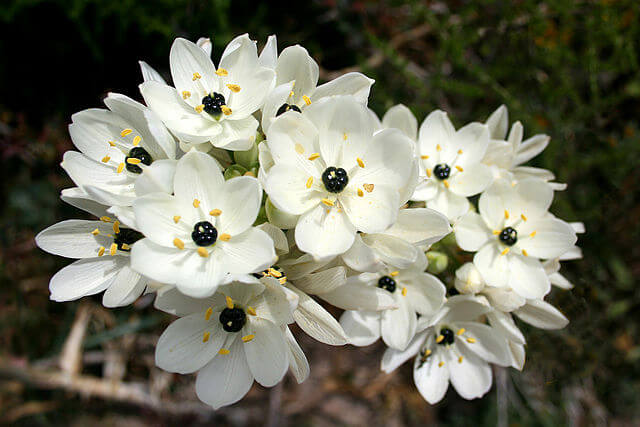

2.7. Large poultry garden - Ornithogalum magnum
Leaves are emerald green, basal, linear, up to 45 cm long, often begin to dry before flowering. Peduncles reach a height of 30 - 60 cm. Inflorescences are cone-shaped, friable - they bear many delicate, white flowers with oblong, thin petals. The flowers open upwards and the total flowering time is quite long. The flowering period begins in late spring.


2.8. Saunders' birdhouse - Ornithogalum saundersiae
A large perennial plant up to 90 cm in height with bulbs up to 20 cm in diameter.Leaves are oblong - xiphoid, green, often covered with a bluish waxy bloom, up to 50 cm long. Peduncles are leafless, thick, vertical, bear round inflorescences at the top with many small white or cream flowers.
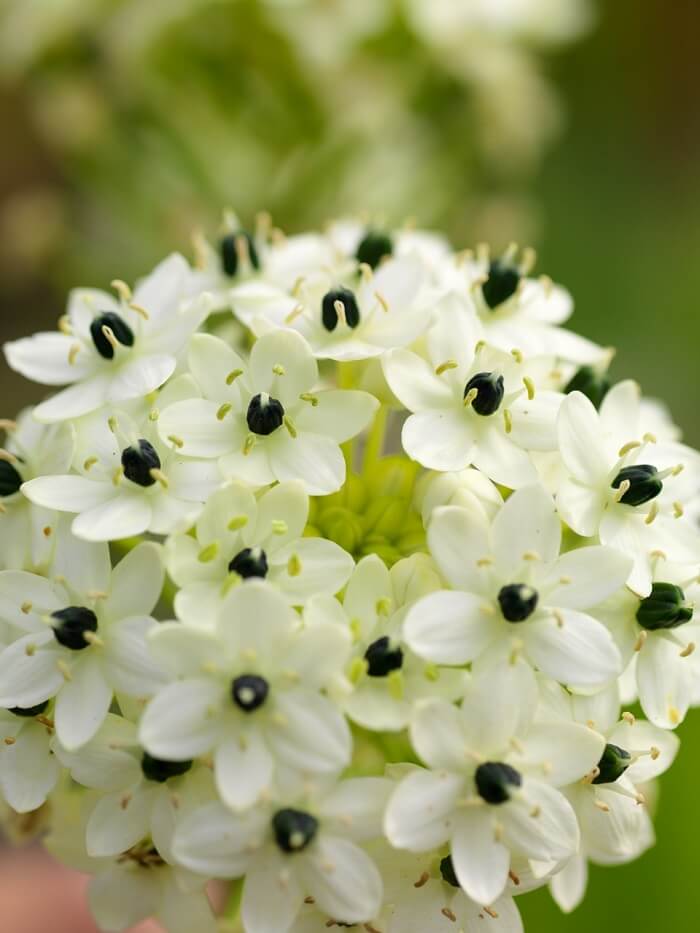

2.9. Koch birdhouse - Ornithogalum kochii
One of the smallest types of poultry - even adult plants do not exceed a height of 10 cm. The leaves are narrow, linear, slightly curved, dark green, glossy, often die off even before the flowers appear. Peduncles are short, strong, erect, bearing several charming, silvery-white flowers. The center of the flowers is colored light green. On the outside, the flower petals remain green.


2.10.Thyrsoid poultry - Ornithogalum thyrso> Herbaceous bulbous plant with a height of 20 to 50 cm. Leaves are green, linear, 15 - 30 cm long and only about 1 cm wide, begin to die off even before flowering. The flowers are delicate, white, collected in an inflorescence - an ear on the top of a low, strong peduncle. Each peduncle is capable of carrying from 30 to 50 flowers, opening sequentially - from bottom to top. The flowering period begins in late spring - early summer.
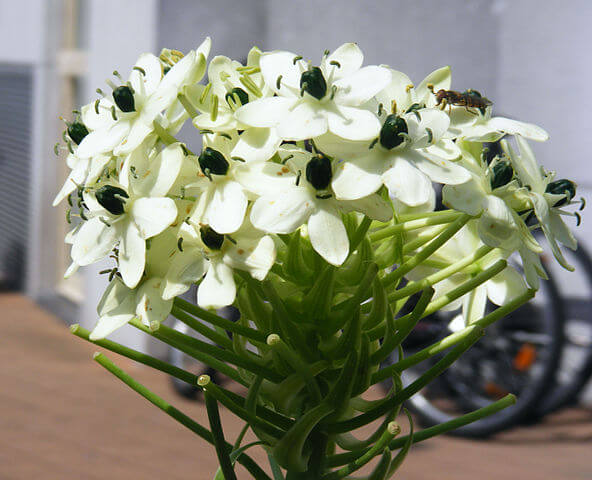

2.11. Poultry arcuate - Ornithogalum arcuatum
Perennial bulbous plants with green, thick, fleshy, oblong - triangular leaves, probably the highest type of poultry. The bulb reaches a diameter of 30 cm, and the flower stalks can grow up to 120 cm in height. The flowers are white, star-shaped, with 6 thin, narrow petals, collected in loose inflorescences - panicles on high peduncles.
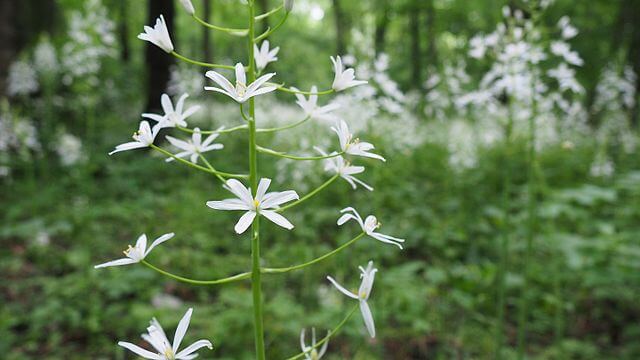

You may also be interested in:
Popular species and varieties
The early varieties of the poultry garden delight with flowering already at the beginning of May, releasing arrows along with the spring-blooming beauties of hyacinths, tulips and daffodils. These are mainly low-growing bushes with a height of 15-20 cm.


Ornithogalum magnum Krasch
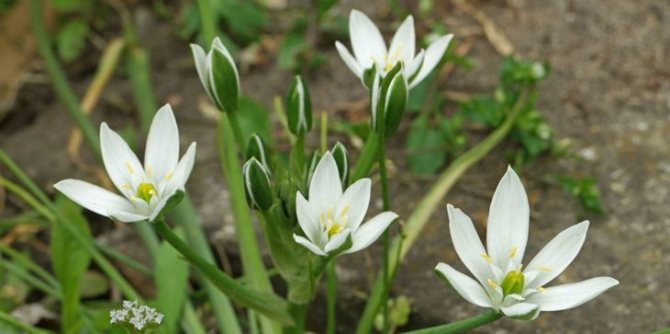

Ornithogalum umbellatum
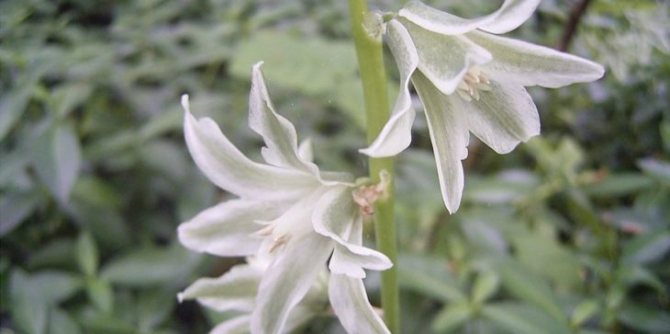

Ornithogalum nutans


Ornithogalum pyrenaicum
In garden design, the following types of poultry farms are most common:
- Ornithogalum magnum Krasch - Large poultry farm. The plant is 40-45 cm high, formed from linear pointed leaves. It has loose large inflorescences, including about two to three dozen flowers with a diameter of 3.5 cm. It blooms from mid-July for three weeks.
- Ornithogalum umbellatum - Umbrella. Herbaceous bush 25 cm high with narrow bright green leaves and white flowers 2.5 cm in diameter. Blooms from early June for two weeks.
- Ornithogalum nutans - Wilted. Plant with broad-lanceolate leaves 5-6 cm long and thin peduncles 35 cm high. Buds 4.5 cm in diameter have a silvery-white color with a green tint.
- Ornithogalum pyrenaicum - Iberian. A bush with bluish-green linear leaves 40 cm long and a powerful peduncle 75 cm high. Lush pyramidal inflorescences have up to 60 white buds with a diameter of 2-3 cm.
Flowers of the variety have an interesting orange color Ornithogalum dubium... Bushes look spectacular in plant compositions Ornithogalum arcuatum Stev with large inflorescences of creamy milky buds. It is widely known as a room culture Ornithogalum caudatum - poultry farm Tail. Gardeners often refer to it as the Indian onion, Hell root or White Brand. The plant has a large green-white bulb with a diameter of 8-9 cm, the burning concentrated juice of which has an analgesic effect. In folk medicine, Indian onions are used to treat bruises and relieve joint pain.
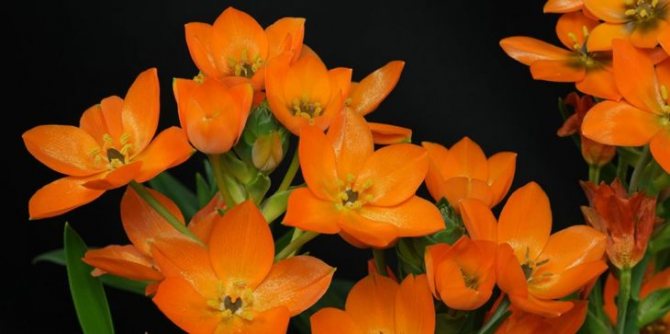

Ornithogalum dubium
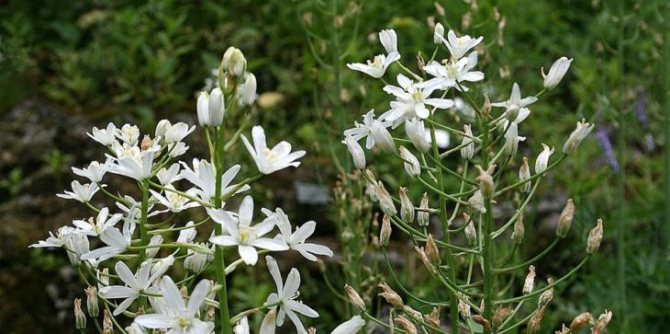

Ornithogalum arcuatum Stev Ornithogalum caudatum
It should be borne in mind that some varieties of "milk stars" are poisonous. The leaves and bulbs of plants contain organic compounds - glycosides, which affect the functioning of the nervous and cardiovascular systems. A concentration that is dangerous to health is contained in one small onion. The main signs of poisoning are nausea, vomiting, in severe cases - kidney damage and blood clotting disorders.
What is so interesting about such a street flower?
This bulbous "creature" is the closest relative of the hyacinth. There are a lot of plant species - about 150. It is not surprising that you can find them all over the world: certain types of poultry farms grow in nature in Europe (subtropics of the Mediterranean), Africa (southern countries), Asia (western countries), in both Americas. By the way, there are only 10 cultivated plant species!
The flower has many popular names: the milk star (this name is popular among the Germans), the star of Bethlehem (Britain), or just asterisks.
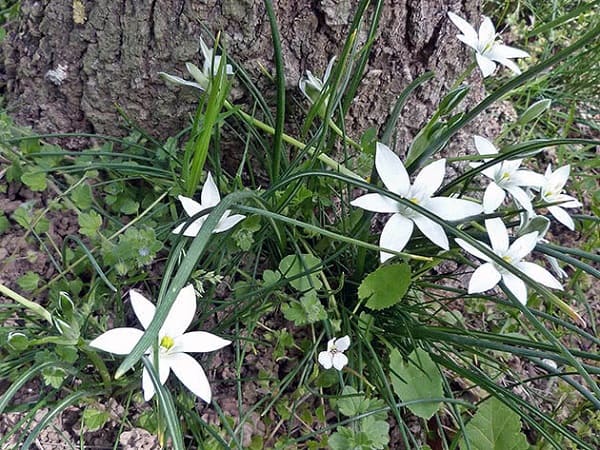

This garden plant blooms in May, from about the beginning to the end of this month (continuously, for 3 weeks).
In addition to a purely decorative function, ornithogalum is also a useful, medicinal plant. The flower has wound healing, analgesic, antimicrobial properties. But! You shouldn't "write out" it yourself. The fact is that I know that some species of ornithogalum are poisonous.Therefore, I recommend treating with such a plant only after the "blessing" of a therapist or at least an experienced herbalist.
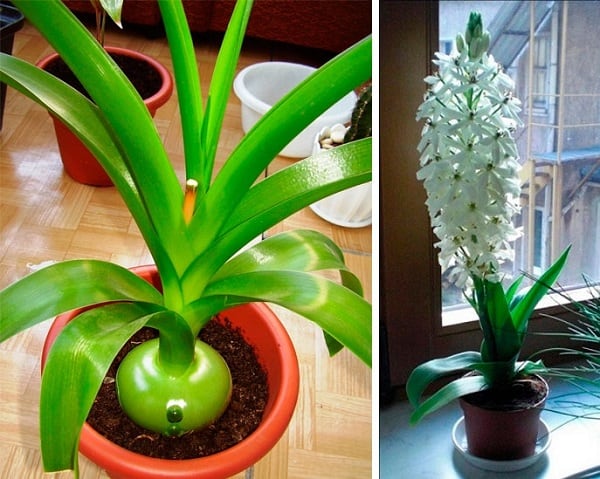

One thing I know for sure - not dangerous, but the crested poultry farm (Indian onion or brandy) is considered useful. Here is a photo of this indoor plant:
Most types of garden ornithogalum look like this
- Rounded bulb 2 to 5 cm wide. In shape, it can be either oblong or ovoid. The sides of the bulbs are covered with dense scales.
- A herbaceous bush, which, depending on the species or variety, grows up to 30 or 85 cm.
- Green leaves of "grass", decorated with a whitish arrow in the center. In most species, they grow in early spring, but there are poultry farms, the foliage of which breaks through in the fall, hibernates successfully, and dies off at the beginning of next summer.
- Flowers open on a long peduncle, individually or with a brush. Their shade can be white, cream. There is also an indoor view with orange flowers. Ornithogalum flowers have no smell.
- At the end of flowering, the fruit is formed - a box filled with black, flat seeds.
Appearance and features
Poultry bulbs are round or elongated. In spring, along with blue snowdrops, the plant produces arrows with white or light yellow odorless flowers. Flowers form clusters or thyroid inflorescences.
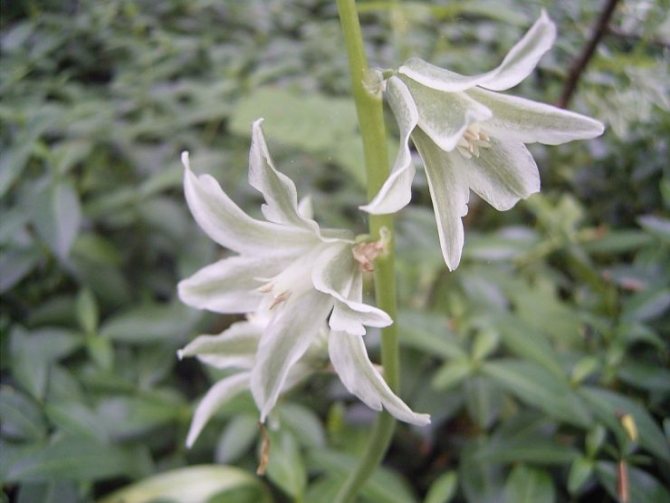

Some of the poultry varieties are poisonous. Others are edible. Gardeners grow about a dozen species known as asparagus.


Planting bulbs in the garden
For a poultry farm, it is better to choose an area in the bright sun or in a light partial shade.
The soil is suitable for the plant, light, quickly absorbing rainwater. Ideally, if it is sandy (while it can be infertile). But clay (heavy, tight) soil will not work for the poultry farm.
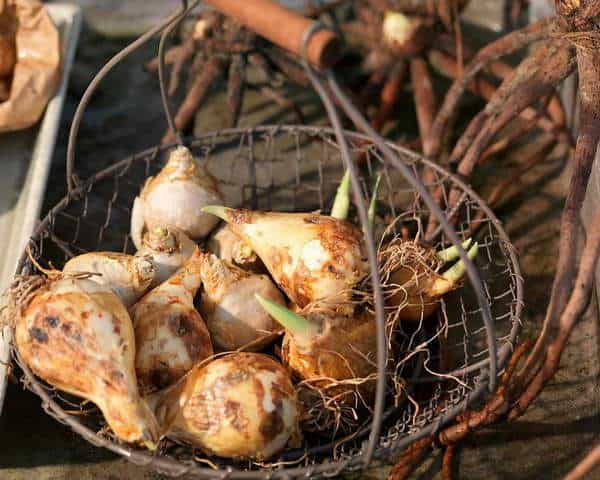

Bulbs can be sent to open ground not in spring, but closer to autumn - from August to September. If you got a thermophilic species (a dubious or Arabian poultry farm), it is better to plant it in the spring (at the end of April), and dig it up and transfer it to the house in the fall. The bulb can either be planted in a pot or put in a cellar for storage (a good option is 6 degrees Celsius and a box of sawdust or straw).
Planting a poultry house step by step
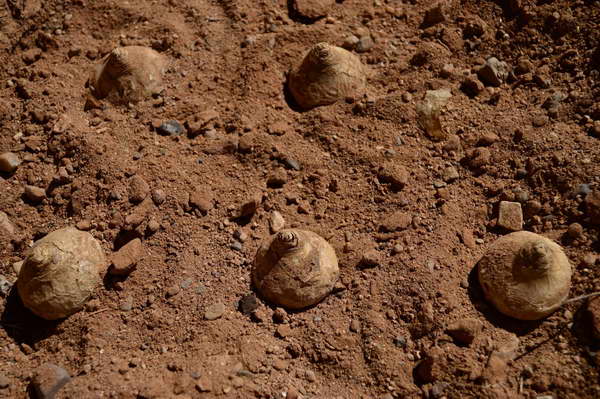

- Dig up the flower bed. If the ground is dense, add coarse sand.
- Make shallow (6-10 cm) pits. The correct depth for each individual bulb is three heights. That is, if the "growth" of the bulb is 2 cm, plant it 6 cm, and so on.
- Distance - 15 to 20 cm between future flowers. The poultry plant is planted in groups.
- Place an onion in each hole, sprinkle it (completely), water immediately.
Since the planting takes place before winter, a couple of months later it will be necessary to prepare the flower bed for winter. In the southern regions or in the middle lane it is not necessary to insulate it in any way, a snow "blanket" is enough for the poultry farm. If in your area winters are famous for high frosts and snowlessness, cover the ground with moss or spruce branches.
After flowering


After the leafy ones completely wither, they will need to be cut off. In the middle latitudes and southern regions, the plant does not need shelter for the winter. However, if the winter period is with little snow and rather frosty, then the area where the ornithogalum grows should be covered with spruce branches. If you grow thermophilic species, which include a dubious bird farm and an Arabian bird farm, then the bulbs must be dug up in the autumn and planted in flower pots or put in a cellar for the winter. They are planted in the garden in spring.
Flowering plant care
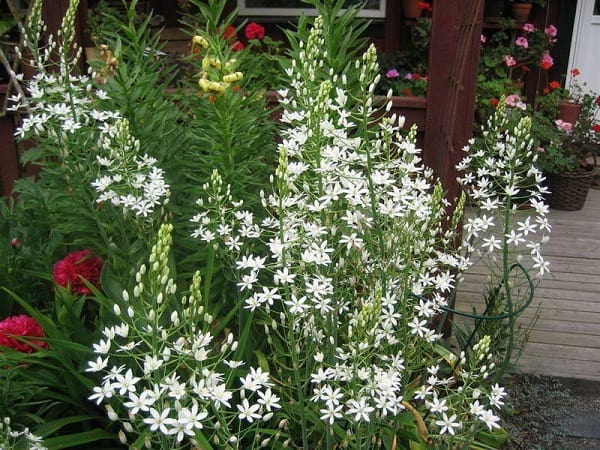

- Watering. Water the flower with a moderate amount of water, but often. Do not let the bulbs grow in a puddle, they will disappear in it.Water the flower bed so that all the water goes into the soil. If the flowers fall, and the leaves turn yellow, think about it: these are symptoms of waterlogging of the plant. By the way! During flowering and seed formation, the plant needs less water than usual.
- Food. During flowering, the bulbs have enough nutrients in the soil. But closer to autumn, when they are preparing for wintering, they should be additionally "refueled". Buy a complex mineral fertilizer. Prepare the solution and process the flower bed once in August. Also, in the fall, organic matter can be distributed in the flowerbed (say, in the form of mulch).
- Diseases. Ornithogalum is considered a very strong, not painful plant at all - unless, of course, it is transfused.
- Pests. They, too, rarely attack the flower. However, sometimes the beauty of ornithogalum can suffer from aphids. It is better to immediately etch it with an insecticide (say, "Biotlin"). Also, the poultry farm sometimes suffers from spider mites. In this case, acaricide is already being bought - poison from ticks.
So that the plant does not stop blooming, the poultry farm needs to be thinned out from time to time.
The grass has faded - what's next?
When all the leaves of the plant wilt and turn yellow, they need to be cut off. In winter, the poultry farmer does not need such a "blanket". Let me remind you: if you have a species that grows leaves for the winter, you should not touch them.
As I said above, most types of bulbs winter well in the ground. If the winter is snowless, it is better to insulate the soil. Also, bulbs can be spud in the fall.
The most frost-resistant types are considered: drooping, umbrella or poultry balance.
Transplant: why, where and how often?
Over time, each bulb grows overgrown with children, and the flower bed can no longer feed them. In addition, the bushes also do not become more decorative from this.
Ornithogalum can grow in one flower bed for 4, maximum 6 years. Then transplant it, thoroughly thinning it out (that is, separating the children).
In early spring (while the "guys" have not sprouted yet) or at the end of summer, dig up all the bulbs, separate them, and transfer them to a sunny or slightly shaded place. Done!
Diseases and pests
Ornithogalum has excellent immunity. Subject to the regulations on the content, problems should not arise. Of the diseases, although rare, gray rot is still noted. Its development is associated with a violation of the agricultural technique of cultivating a potted culture - too frequent and abundant watering. The plant is treated by spraying with a solution of a fungicidal preparation.
Among the pests on the shoots, the feeding of spider mites and aphids is noted. Settling occurs in excessively dry air. At the initial stage, a folk remedy - soap solution will help against harmful insects. They are sprayed with shoots at intervals of several days. If the settlement is intensive, it is better to use more effective means of protection - insecticides.
Reproduction of the poultry farm
Seeds
Before winter, dig up a flower bed, make shallow grooves, sow seeds and cover them with soil. For the winter you need to forget about them. The "guys" must undergo stratification, that is, natural cold treatment for 3-4 months. In the spring you will see numerous leaves.
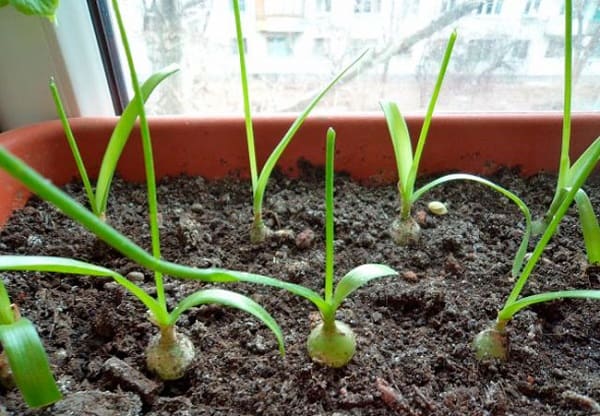

If you have snowless winters and constant spring return frosts, and you are afraid that the seeds or seedlings may die, grow seedlings in the house. In early spring, sow seeds in containers filled with light soil (say, garden soil mixed with sand, or a mixture of sand and peat).
When you see 3 real leaves, start hardening the seedlings by taking the container outside or on an open balcony for 2-3 weeks. Do it without fanaticism - on the first day, keep them there for only 10 minutes, then 20 ... By bringing the time in the fresh air to a day, you can transplant the flower into the garden.
The poultry garden grown from seeds has only one drawback - it blooms as much as 4-5 years of age.
Kids
I have already spoken a little about them above.If someone you know has been growing a poultry garden in the garden for several years, you can ask for one or two bulbs. Get a whole "dowry", which will only be divided and planted throughout the flower bed. And most importantly, such a poultry farm will bloom much faster than grown from seeds.
Distribution and history
The flower grows naturally in subtropical and temperate zones. South Africa is considered his homeland. It is also found in Europe, Russia, Asia and America.
About 30 species grow in Russia.
At first, the Poultry Farm was brought to Europe from South Africa, after which they began to grow various species for decorative purposes and the flower was distributed throughout the world. The poultry plant was brought to Russia in 1961.
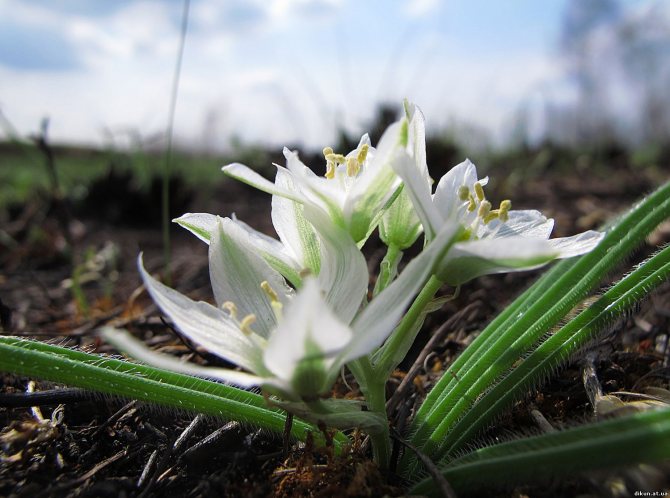

The poultry plant grows all over the world
Let's summarize
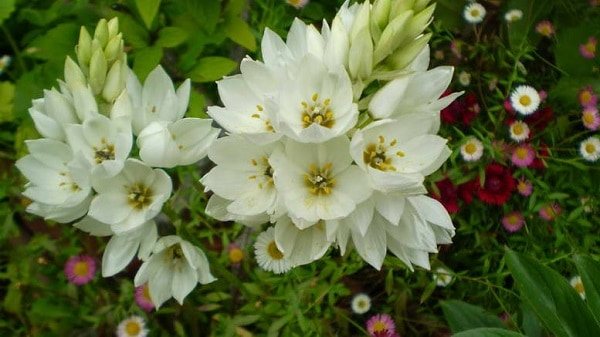

- The poultry garden, also known as ornithogalum, is an ornamental flowering garden herb. Although out of ten cultivated species, there are also two indoor. They can be grown all the time in an apartment or transplanted into a garden only during the summer.
- It is better to grow a flower in light soil (sandy, you can use not the most nutritious one), on the sunny side of the site.
- In the summer, ornithogalum needs to be watered often, but carefully, and closer to autumn, fed with a complex "mineral water". The flower almost does not get sick, and it rarely suffers from pests.
- This flower multiplies with the help of baby bulbs. It can also be grown from seeds, but in this case, the poultry farm will not bloom soon - after 4-5 years.
But ornithogalum can be bred not only in the garden. Such a flower (and more specifically, a dubious birdhouse with bright orange flowers) is also grown in a room pot.
Doubtful birdhouse
The plant got this name because of the orange, yellow or red flowers collected in a pyramidal brush.
This species does not grow in Europe. However, shoots with bright lush inflorescences are often used in floristry. Flowers stay fresh for a long time.
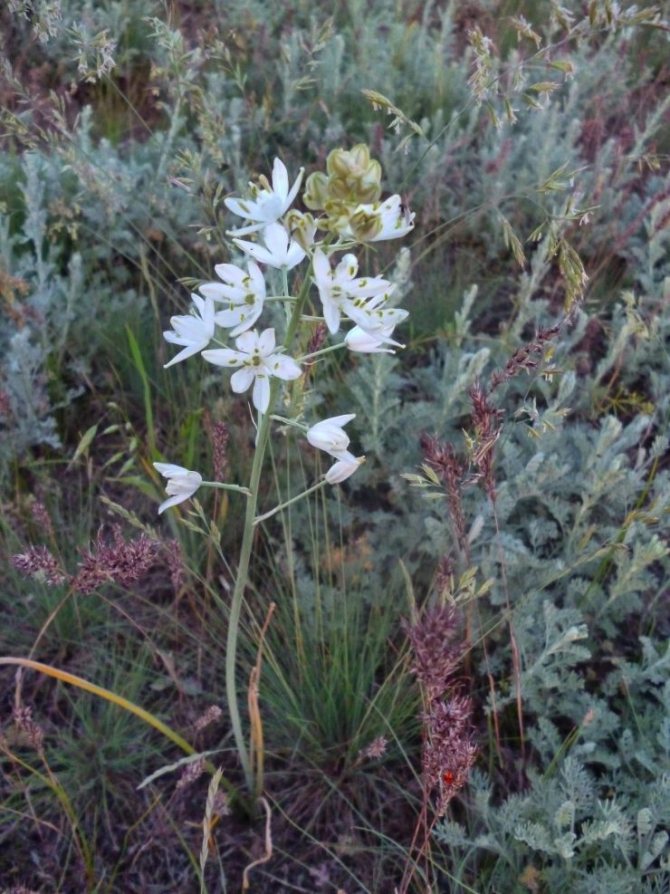

Spread
Indian onions in the wild are found mainly in temperate and subtropical climates. The culture is actively cultivated as a horticultural and economic crop throughout Europe and Asia. The natural habitat of culture is the shores of the Mediterranean Sea and southern Africa. Indian onions are cultivated in South America. Some representatives are found in North America.
Indian onion has a variety of species, however, 4 representatives are today in the Red Book. Today, plants are actively cultivated at room temperatures, for decoration of plots and garden areas.
In the wild, the poultry farm lives in coastal areas. In addition, the culture grows on slopes and highlands. The culture prefers nutritious soil and optimal air humidity.
Growing conditions
To successfully grow a poultry farm on your site, you need to determine what conditions are most favorable for it:
- During the period of vegetative growth, the plant needs organic feeding.
- During flowering, more moisture is required; during the period of seed formation, the amount of watering should be reduced.
- A plant culture should be transplanted every 4-6 years.
- In winter, with abundant snow cover, the poultry farm does not need additional shelter. But if there is little or no snow, it becomes necessary to mulch the soil and cover it with spruce branches.
Wintering of the poultry farm
Most species tolerate wintering well, without creating additional growing conditions. However, it is necessary to prepare the plant for the dormant period. For this, immediately after flowering and ripening of the fruits, the aerial part of the plant is completely cut off, leaving only a few cm from the ground. Heat-loving varieties for the winter are additionally covered with a layer of mulch or dry foliage.As a shelter in cold winters, with a small amount of snow, spruce branches are used.
Some gardeners recommend digging out thermophilic species for the winter. After removing the bulb from the soil, it is planted as a room culture, or placed in a cellar, where the plant will overwinter. In the spring, these bulbs are placed back in the open ground, after the end of severe frosts. Under normal conditions, the culture germinates quickly and produces new leaves.
Birdhouse from seeds
Poultry seeds photo
It is better to sow poultry seeds before winter for natural stratification.
If you decide to grow ornithogalum seedlings:
- Place a bowl of sown seeds for a month in the refrigerator or under the snow. The seeds must be fresh, as they quickly lose their germination.
- The sowing container must have drainage holes in the bottom.
- Planting substrate can be used ready-made for flowering plants.
Hatching seed of ornithogalum photo
- A month later, after passing through stratification, place the container in sunlight, covered with plastic wrap or glass. The seeds will not germinate at the same time.
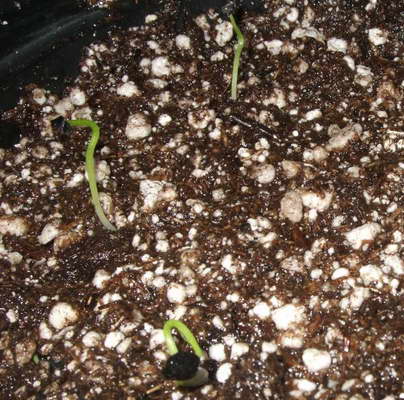

What do ornithogalum seedlings look like?
- Try to initially sow the poultry house as little as possible in order to avoid subsequent diving (distance of at least 5 cm). You can immediately place 1 seed in separate cups.
- Polyethylene is removed every day for ventilation for a few minutes, gradually increasing the time.
- Watered little by little, as the substrate dries.
- Young seedlings can develop in this container without transplanting until they grow up, and then they can be planted in a permanent place.
- Plants will bloom with good care in 5-6 years.
First steps after purchase
The purchased bulbs must be stored at a temperature of + 25 ° C (only a month before the planned planting it is lowered to + 17 ° C).
If bulbs with damage or cuts are found among the planting material, it is better to get rid of them as a possible source of disease.
If it is decided to grow Poultry immediately after purchasing the planting material, the bulbs are planted in the soil (preferably poor), watered and left warm. As soon as the first leaves appear, the seedlings move to a warm, bright place and are fed with fertilizer for bulbous plants.
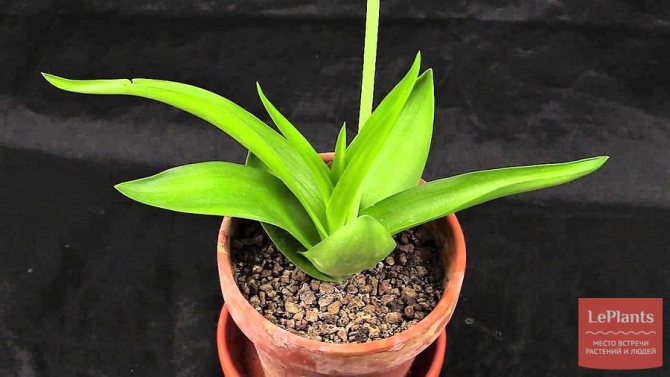

ON THE PICTURE: Young plant of the Poultry plant.
Reproduction of a garden poultry farm by seeds
The reproduction of the poultry farm with daughter bulbs and seeds is equally successful, but the seed method requires more trouble and time from the gardener.
When propagating Indian onions by seeds, you can get many more babies. True, in order to get the seeds of a grown plant, you must first pollinate it. This is done at the time of flowering (in the second year of the plant's life) using a brush.
When the pod is dry, the seeds are collected and sown in boxes filled with fertile soil. When the seedlings have thrown out 4 petals, they can be planted separately.
Seeds need stratification, so it is better to sow them before winter. Then they will undergo natural stratification and friendly shoots will appear in the spring.
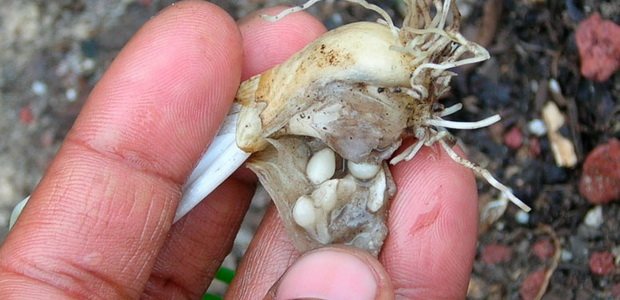

Many gardeners prefer to grow seedlings from seeds, and then plant already matured plants in open ground. For growing seedlings of a poultry farm, small containers are taken, for example, disposable plastic cups, peat pots. The containers are filled with a light, nutritious substrate, where the seeds are slightly buried. Crops are regularly moistened, kept in a well-lit room. When young plants have 3 - 4 leaves, they begin to harden, exposing them to the street, gradually increasing the time spent outdoors. At night, seedlings are brought indoors. After the plants can be outdoors throughout the day, they can be transplanted into a flower garden.
Plants obtained with the help of seeds bloom in the 4th - 5th year.
Description of the birdhouse ornithogalum
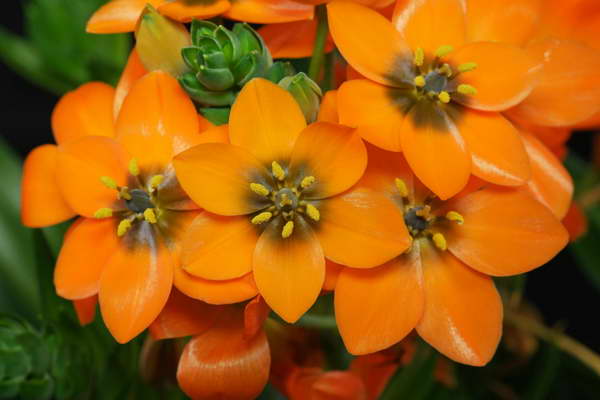

Birdhouse orange Ornithogalum dubium photo
Perennial bulbous plant Ornithogalum of the lily family. The stem is absent, the leaves are long, belt-like, dark green in color, appearing before the peduncles. The flowers are light yellow or white with a green stripe on the outer side of the perianth, collected in corymbose or racemose inflorescences of varying density at the apex of the peduncle.
A characteristic feature of the poultry area is six-petal flowers, on the back of each of them a green stripe is drawn. The bulb is covered with white papery scales. Baby bulbs are very fond of climbing up the juicy scales and often find themselves above the ground. Thanks to the numerous children, the plant reproduces easily.
Ornithogalum is considered an exotic flower and is successfully used by florists to create bouquets and compositions. The poultry garden has frost-resistant species, suitable for personal plots in central Russia. There are several species that cannot stand frosty winters and are suitable only for indoor floriculture. The species of the poultry plant differ in the shape and size of the peduncle, the color of the flowers.
When purchasing bulbs, you should pay attention to the condition of the covering scales and the bottom. The presence of stains and mold is indicative of disease. The bulb must be dry and clean, without traces of mechanical damage. At the bottom, the presence of root rudiments is encouraged. If there are dry roots, it is better not to buy one. Before planting, place the bulb in a solution of hydrogen peroxide (1 teaspoon per liter of water) - this will disinfect the planting material, and active oxygen stimulates awakening and rapid growth.
Care rules
The poultry garden is an unpretentious culture, therefore, even not the most experienced florist can cope with its content.
In order for the plant to grow healthy and bloom with delicate flowers, you must follow the basic rules for caring for it:
- Watering the poultry farm is required regularly, but in small quantities. Waterlogging of the soil can be detrimental to the plant;
- After the beginning of flowering and the formation of seed bolls, watering must be reduced;
- The poultry garden responds well to the introduction of organic matter. Feeding is better in the fall. This is especially important if the soil is poor or the plant grows in indoor conditions.
Note: some heat-loving species (the dubious and Arabian poultry) can die in the winter, so it is advisable to dig their bulbs for the winter.
At the end of flowering, do not forget about the culture. After the leaves have completely died off, they must be cut off. In regions with a mild climate, the culture can winter without shelter. And in cold climates, especially in winter, when there is little snow, it is advisable to cover. Spruce branches are suitable as a material for shelter.
Soil, lighting and moisture indicator for a flower
Initially, the seedlings are planted in prepared soil. The ideal mixture will be, per 1 sq. m:
- 10 liters of humus and peat;
- 5 liters of rotten foliage (or leafy earth);
- 3-4 liters of river sand;
- 2-3 liters of vermiculite.
In the future, until the next transplant, you can completely do without top dressing.
For successful growth, the culture needs bright lighting and the absence of stagnant water. The best is a hilly, sunny area.
In the fall, planting does not need watering and feeding.
Top dressing and watering
After the snow melts, the seedlings are cleared of mulch. Further care consists in regular watering and weeding. No fertilization is required in the current season.
In the next season, as a top dressing, nitroammofosk is used (crumbles) at a dosage of 25 g per square meter. After bud formation and until the end of flowering (twice a month), superphosphate can be added to the water for irrigation. Enough 15-20 g bucket of water.
Pruning after flowering
Autumn pruning of the plant is carried out only after the aerial part, that is, the peduncle and leaves, has dried. Before drying, they transfer to the bulb all the useful juices necessary for wintering and setting flower buds.
Important! The very top of the onion should in no case be injured. The plant may die.
Success secrets
During the budding period, the Poultry Farm will require more frequent watering. However, stagnation of water in the ground is strictly unacceptable. In dry, hot weather, it is useful to spray the leaves with clean water at room temperature.
At the first signs of drying of the tips of the leaves, it is necessary to add succinic acid to the water for irrigation and spraying at the rate of 1 g per 1 liter. water, as well as potassium nitrate - 1.5 g per 1 liter.
To preserve the health of plants, it is desirable to provide a temperature of + 10-15 ° С during their rooting, then gradually increase it to + 20 ° С.
Contraindications
The poultry garden is a very poisonous plant, so folk recipes are not used internally. It is important to avoid contact with mucous juice, carefully apply the culture. Before treatment, it is recommended to consult a doctor who determines the indications for taking the substance. Before using the medicine with Indian onions, an allergy test is performed - the agent is applied to a small area of the skin. You can not take funds to people under the age of 18. The poultry farm is contraindicated in hemophilia, allergies and kidney failure. The period of gestation and feeding is also a limitation to treatment.
Conditions for keeping poultry in the garden
In order for the poultry bush to please the eye for a long time with its well-groomed appearance, good conditions should be created for it. This is not difficult to do, since the plant is unassuming to care for, requires a minimum of attention.
Location. The poultry garden is not very picky about the abundance of sunlight, despite the fact that it is photophilous, this flower grows well in partial shade. For its cultivation, areas between trees with spreading crowns are suitable.
The soil. Prefers fertile, drained, neutral soils, but tolerant of poor soils. This culture grows well on sandy soils. Does not tolerate excess moisture.
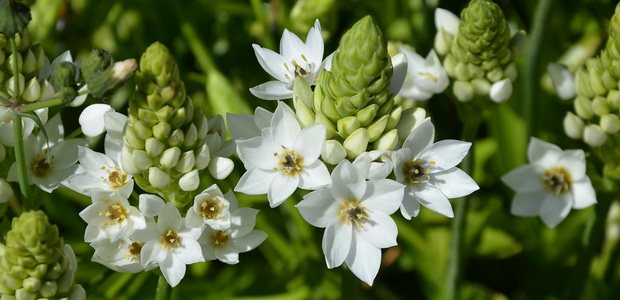

Watering. Ornithogalum is hygrophilous and requires regular but moderate watering. Excess moisture negatively affects the well-being of the plant. The leaves begin to turn yellow, and the buds fall off without opening. Often, excessive watering leads to rotting of the bulbs and the death of the bush.
Top dressing. Additional fertilization is not necessary if the soil on the site is fertile enough. Otherwise, top dressing with full mineral fertilizer is necessary after the snow melts, during budding.
Shelter for the winter. Most types of poultry farms are highly frost-resistant, therefore, after the bush has faded, the aboveground part is cut off, leaving no more than 10 cm from the soil surface and the plant is left for wintering in the open ground.
For the winter, plantings of thermophilic species are covered with mulch in the form of sawdust, spruce branches or dry leaves. When breeding ornithogalum in harsh climates, the bulbs are dug up in autumn and stored in wooden boxes, which are kept in a cool room until spring.
Transfer. In one place, poultry farms in the garden can stay up to 5 - 6 years, but after this time the bushes begin to crumble and lose their decorative effect. For this reason, the plant needs a rejuvenating transplant. To do this, the flower is dug out in late August - early September, the bulbs are separated and transplanted to a new place.
The next selection of photos shows how the care of a bird-house flower (ornithogalum) in the open field after planting is carried out, after viewing which, you can easily cope with this work:
The use of bulbous poultry
Bulbous ornamental perennial - poultry plant is often used in landscape design to decorate the garden area and the local area. Ornithogalum is planted in the foreground of mixborders, used in group plantings. The flower also looks beautiful along the paths. The umbrella look is suitable for creating alpine slides and rockeries.
Thanks to its decorative foliage, it goes well with early flowering plants in various types of flower beds, for example, irises, primroses, daffodils, hyacinths, hosts, aquilegia.
These flowers are used when making bouquets, because they not only add a special charm to the composition, but also stand in the cut for a long time.
The Arabian poultry farm is suitable for forcing.
Some types of poultry plant (ornithogalum) have found application in folk medicine, since bulbs, inflorescences, leaves have useful properties. The healing parts of the flower are harvested, and the raw materials are used to heal wounds, relieve swelling, and eliminate pain in case of bruises. In addition, poultry infusions are used to treat joints. This flower disinfects the air in the room, kills viruses and germs.
Growing at home
The poultry garden can be grown not only in the garden, but also at home. The plant not only adds decorativeness to the room, but also has useful properties. However, when cultivating, it is also necessary to follow the rules of care.
Growing at home is carried out in deep, but not wide pots. The diameter of the container should not greatly exceed the size of the bulb, since otherwise the plant will give all its strength to the growth of the bulb and landscaping. Enough 3-4 cm from the edge of the pot for normal bulb growth. The culture is placed in a nutrient substrate with a neutral medium. The plant does not tolerate an acidic environment.
When planting Indian onions at home, certain cultivation rules must be followed. The basic rules for planting a poultry farm at home are:
- The soil in the pot should be about 2/3 of the base;
- The bulb is placed in such a way that most of it is on the surface of the earth;
- When planting several bulbs, they are placed in the same pot close to each other.
Homemade varieties tolerate drought quite easily, so they should be watered only when necessary. It is important to provide a good drainage layer and holes in the bottom of the container so that excess water is removed from the pot. Stagnation of water in the soil becomes a common cause of rhizome rot. Unlike horticultural crops, indoor poultry farms cannot be sprayed, so dust from the foliage is removed with a dry cloth.
With proper care, the poultry farm does not shed foliage for a dormant period. In addition, the annual flowering of the plant for half a month is considered a sign of quality care. In summer, it is recommended to take out the poultry farm to the balcony or veranda. In addition, the bulbs can be placed outdoors in the summer and brought back indoors in the winter.
At home, the poultry farm grows quickly enough and gives new bulbs. Therefore, the culture is regularly transplanted. Criteria for replanting a bulb include filling the pot with babies or growing the bulb to the edges of the pot. During transplantation, the babies are separated from the mother plant and cultivated in new containers.
The basic rules of crop care are:
- Lack of stagnation of water in the soil;
- Regular and moderate watering;
- The presence of high-quality drainage at the bottom of the pot;
- Clay composition of the soil;
- Annual feeding of the poultry farm with organic fertilizers;
- Mineralization of the soil at least once every 3 weeks;
- When the soil is depleted, the culture must be transplanted into a new substrate.
A prerequisite for the cultivation of indoor poultry farms is considered to be bright light and the constant presence of the culture on the sunny side of the room.The sun helps to increase the number of flowers and the duration of the flowering culture. Subject to simple rules, the culture retains its decorative effect for 25 years.
Description
The poultry plant is a genus of perennial bulbous bushes belonging to the Asparagus family. According to some reports, the culture is considered one of the Liliaceae family. This is a bulbous culture that is grown not only in the garden, but also as a houseplant. The plant reaches up to 30-80 cm, which allows the cultivation of the poultry farm in various habitats. The second name of the culture is the Indian bow.
The bulbous rhizome is spherical. The tubers are oblong, at the base they have small adventitious roots that extend into the ground. The root surface is covered with a dense scaly crust, about 2 mm thick. The diameter of the bulb of an adult plant can reach 5 cm. The peculiarity of the poultry farm is the constant change of the rhizome, renewal and rejuvenation.
Basal leaves appear from the base of the bulb neck. An elongated linear plate. In the middle of the leaf plate there is a whitish vein, which stands out against the background of the light green surface of the leaf. Leaves appear in the spring, before the formation of peduncles. In some cases, certain types of poultry farms produce foliage in the autumn, and die off by winter. Most often, the leaves grow in several pieces, usually 3-7 basal leaves per crop.
Flowering begins in mid-May, when long peduncles with bright creamy, star-shaped flowers appear on the plant. Peduncles are dense enough, light green in color, glabrous or covered with several leaves. The flowers remain decorative throughout June.
The special shape and color of the inflorescence became the reason for the appearance of such popular names for Indian onions as "bird's milk" or "milk stars". Outside, some of the petals have a small green stripe near the perianth. In different varieties, flowers can be single, collected in long brushes or shields. The buds are odorless, self-pollinated.
After flowering, a fruit is formed on the plant - an achene, inside which flat black or brown seeds ripen. Seed material retains its germination capacity for a long time.
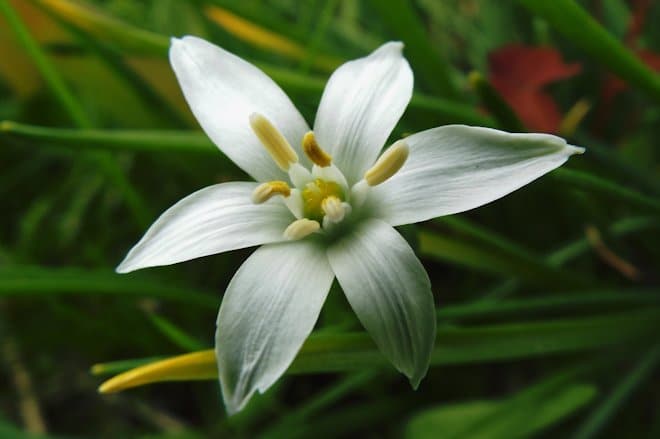

How to care for a plant
Agrotechnical techniques are standard: irrigation, fertilizing, pruning, pest and disease control.
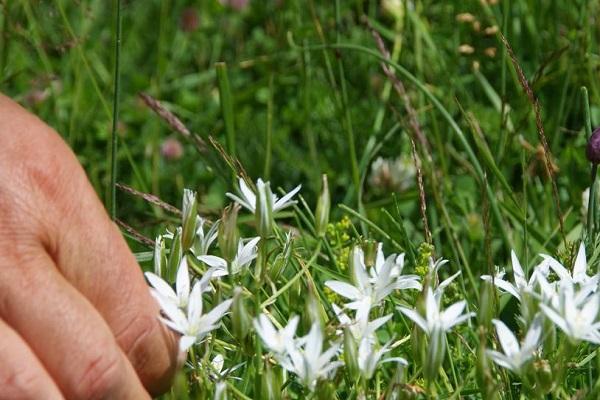

Regularity of watering
Watering ornithogalum should be done regularly, but not overdo it. The plant needs a moderate amount of water. Excessive moisture causes root rot. The poultry farm should be most actively watered during the growing season. Later, during flowering and the formation of seed bolls, the number of water procedures should be reduced.
Fertilizers
The need for a poultry farm for fertilization depends on the quality and fertile properties of the soil in which it is planted. If the soil is rich in nutrients, feeding is not required. Poor and depleted soil, on the contrary, needs autumn feeding. For these purposes, simple organic fertilizers are suitable.
See also
Description of Potentilla varieties Goldfinger, planting and care rulesRead
Transfer
As a result of long-term growth in the original place, the bulb of the poultry farm begins to overgrow with small daughter bulbs. The more of them, the more difficult it is for the bush to grow further - it weakens and loses its attractiveness.


The maximum period for an ornithogalum in one place is six years. Therefore, it is recommended to replant it every 4-5 years. To do this, you need to carefully dig out the bush, separate the young onions that have appeared and plant in a new place. The optimal period for this procedure is late August or early September. You can also transplant in early spring.
Pruning
Every year after the flowering of the poultry farm, you need to cut off dried leaves, wilted inflorescences and other unattractive parts of the plant.
Preparing for winter
Most of the poultry varieties cultivated in our latitudes are cold-resistant, therefore they winter without an auxiliary shelter. In harsh climates, cover the area with fallen leaves or spruce branches.
Heat-loving plant species require special preparation. Before wintering, they should be dug out of the flower bed, temporarily transplanted into flowerpots or other containers filled with a mixture of sand and peat, and with the onset of spring they should be put back in their original places.
Diseases and pests: control and prevention
The poultry farm is most susceptible to the following ailments:
- Gray rot. The disease is identified by the mold that covers various parts of the plant. It is recommended to spray it with insecticides. For small lesions, they should be carefully cut out and sprinkled with wood ash.
- Fusarium is a fungal disease that affects the roots of a plant. At the initial stage, fungicidal solutions can easily cope with this problem, but if the infection has reached a large scale, the plant should be destroyed.
- Onion mites cause the bulb to shrink and become stained. In such cases, insecticidal treatment is carried out.


Reproduction of the poultry farm using baby bulbs
It is much easier and faster to reproduce the poultry farm with the help of bulbs. Many small bulbs form under the outer scales, forming a necklace around the main bulb protruding from the ground. Children are a little flat in appearance and grow very quickly in volume. Growing up, they separate themselves from the main bulb and fall to the ground, into which they quickly put their own roots.
For propagation by bulbs, an adult bush is selected and dug out, the children are separated from the bulb and planted separately in pre-prepared holes. When planting bulbs in prepared soil, cover them with earth only halfway.
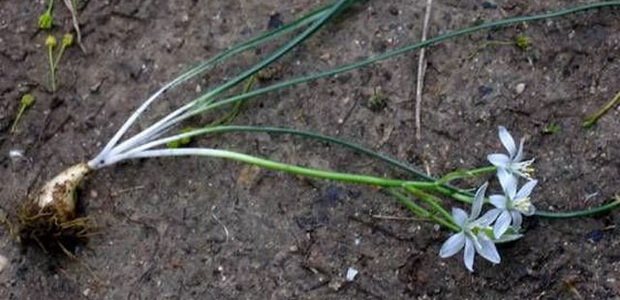

The bulbs are planted in September at a depth of 6-10 cm at a distance of 7-8 cm.
In addition to these two methods of propagation of the Indian onion - poultry, there is a third: by dividing the bulb. To do this, take an onion with a diameter of at least 5 centimeters, cut it in half, cut the roots and leave the bulb to lie for several days. Then they are planted in a pot, watered abundantly and wait for the appearance of young leaves.


